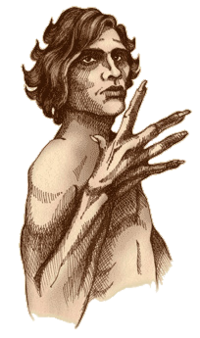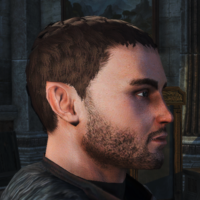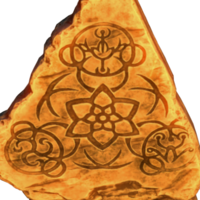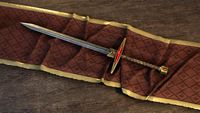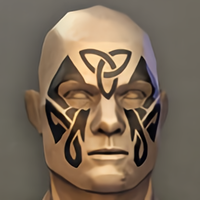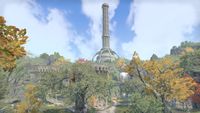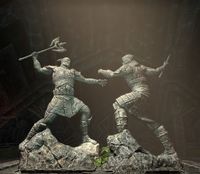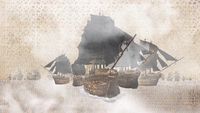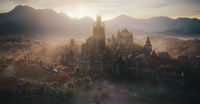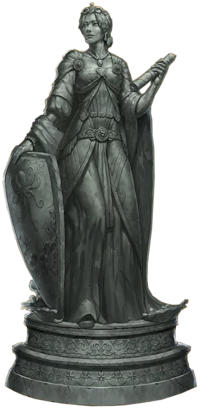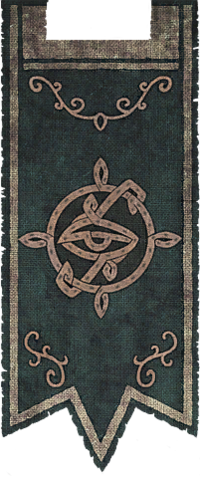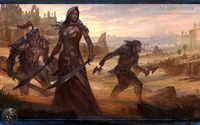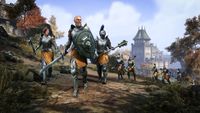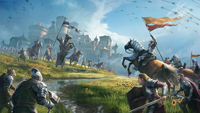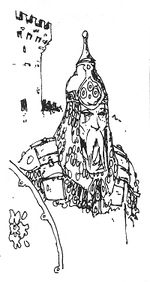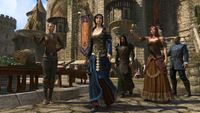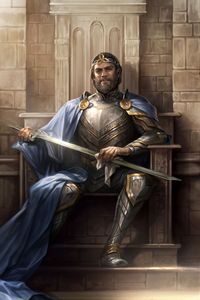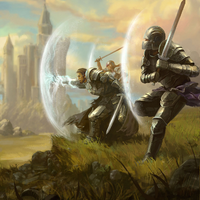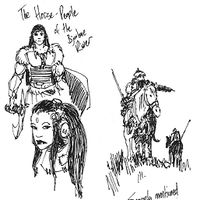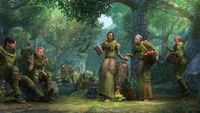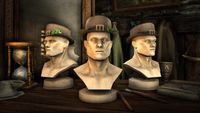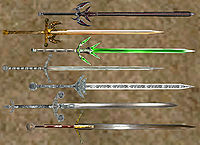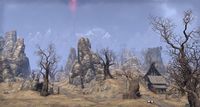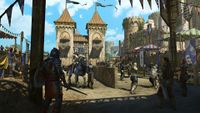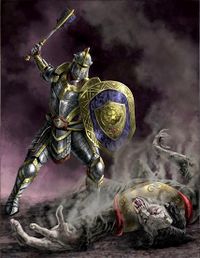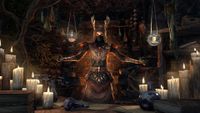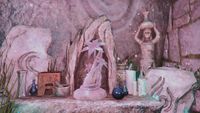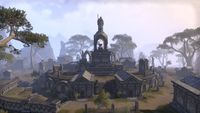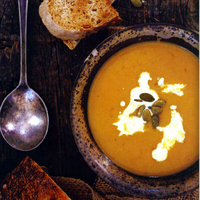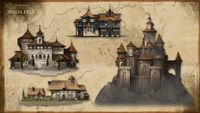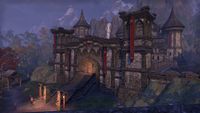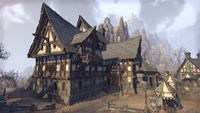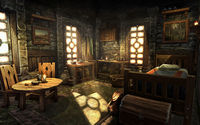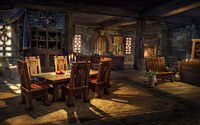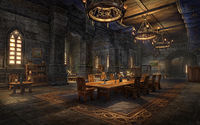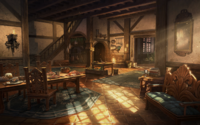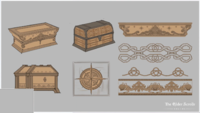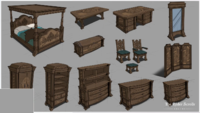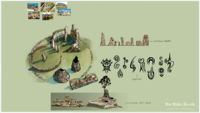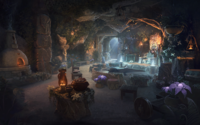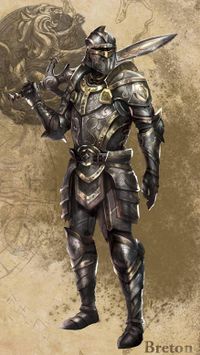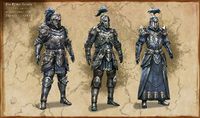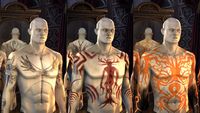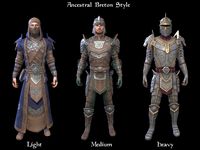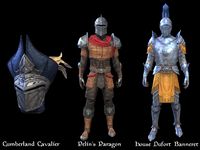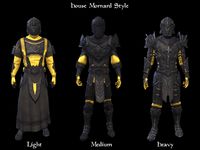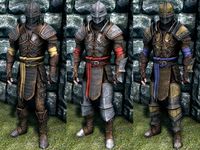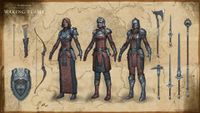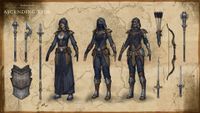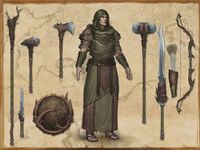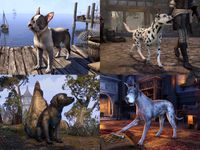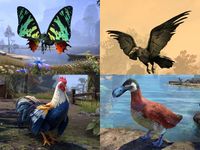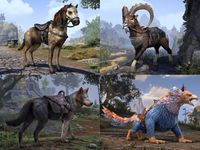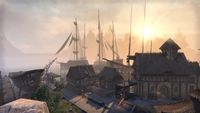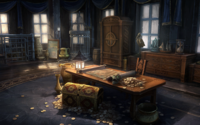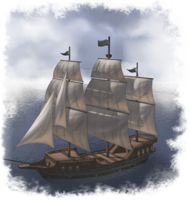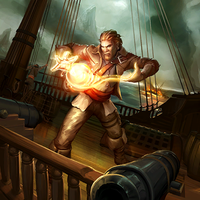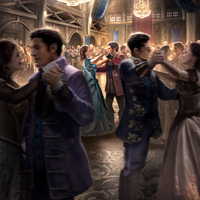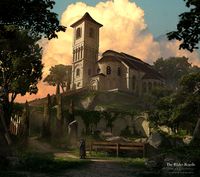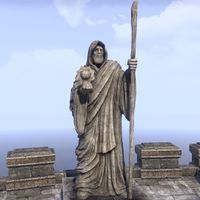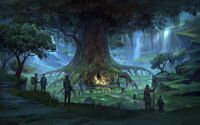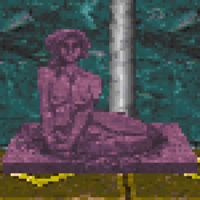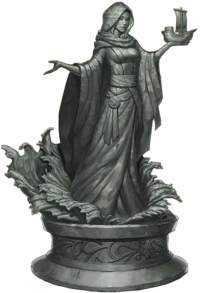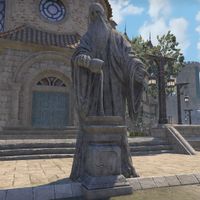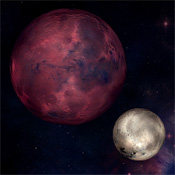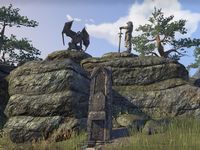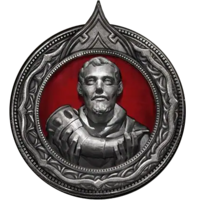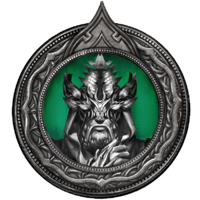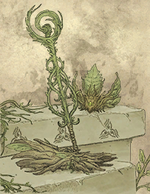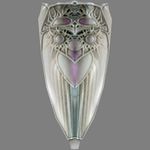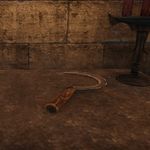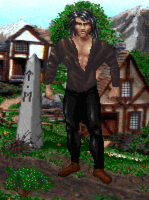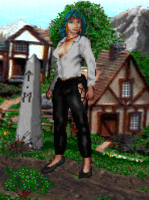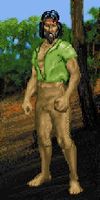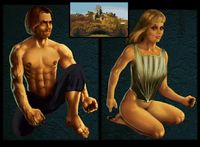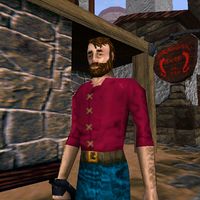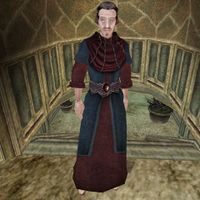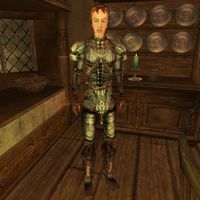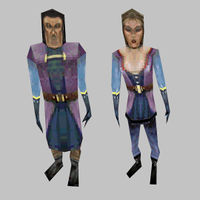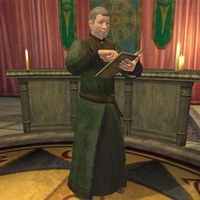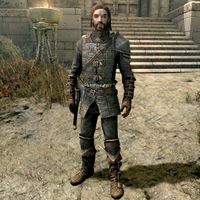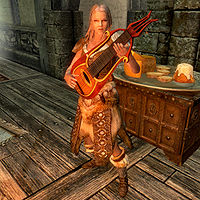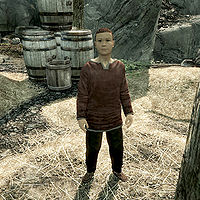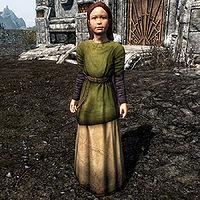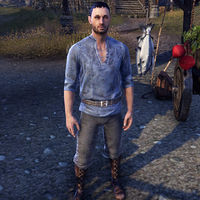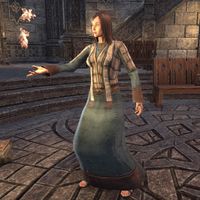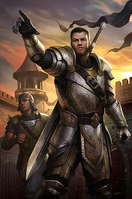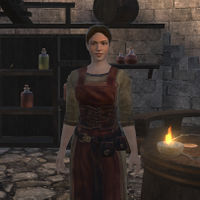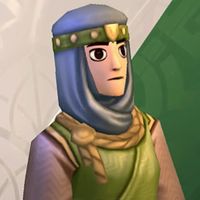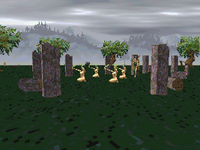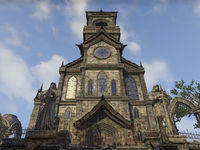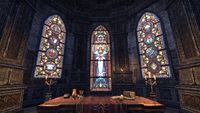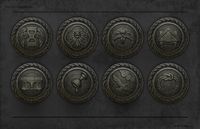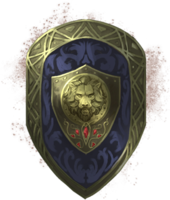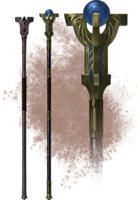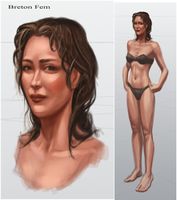Lore:Breton
Contents
Bretons (from the Ehlnofex beratu meaning "half")[1] are a hybrid[UOL 1] race of both human and elven ancestry that primarily inhabit their ancestral homeland of High Rock, and the Systres Archipelago.[nb 1][2][3] High Rock is fractious and divided politically,[4] which is seemingly encouraged by the layout of the land itself.[5] Warfare between kingdoms accounts for much of Breton history.[6] Despite this, Bretons across the province share many facets of culture, including language, bardic traditions, and heroic tales.[4][5] Bretons make up the peasantry, soldiery, magical elite, and ruling families of the feudal kingdoms competing for power within High Rock,[4][7][5] but the race can also be found around the rest of Tamriel, often as merchants or mercenaries.[8] Bretons are distantly related to the Reachfolk.[nb 2][9][8]
Bretondom originated from the Nedes of High Rock and Aldmer interbreeding[10] for centuries as far back as the Merethic Era.[11][12] This mixed ancestry gives Bretons a unique perspective of the Nirn's oldest feud: the conflict between men and mer.[UOL 1] The Bretons' Nedic ancestors are referred to as the Druids of Galen (or proto-Bretons)[UOL 2][13] by retroactive nomenclature,[11][12][14][3] while Clan Direnni are primarily credited as being their Aldmer ancestors.[11][12] Druidic spellcraft (which differs from the arcane) is said to be the first truly Breton creation.[15] Bretons have a natural affinity for environmental manipulation,[16] which druids believe should be utilized to enhance or perfect nature, reshaping it just as their god Y'ffre once did.[17][18]
The Direnni left a significant mark on the Bretons. The race's obsession with nobility, status, and lineage can be traced back to their days as vassals of Clan Direnni.[19] Bretons possess an inborn and instinctive bond for the magical arts, often attributed to their elven blood.[20][6][21] They are known for their intelligence and have a quick and perceptive grasp of spellcraft, enchantment, and alchemy.[22][23][24][21] However, it is often difficult for an individual Breton to leave a lasting impression on the greater magical community; the very same mystical aptitude that produces such widespread natural talent also makes it much harder for Breton mages to stand out. Their human lifespans put them at a disadvantage relative to their elven peers, whose naturally long lives allow them more time to study, hone their skills, and make a name for themselves.[25][26][27] Despite this, several Bretons have managed to cement themselves among the most well-regarded mages in history,[UOL 3] with notable figures such as Voernet, Druid King Kasorayn, and Gyron Vardengroet.[27] Despite the inherent Altmeri weakness to magical attacks,[28] this trait did not carry over to the Bretons. Even the humblest of Bretons can boast a high resistance to destructive and dominating magical energies.[21][29][30]
What it means to be a Breton is considered an age-old quandary by their people.[31] To make sense of it all, some may focus on a specific aspect of their culture, or seek to blend it all together.[15][32][33] Some Bretons hold their elven heritage in high esteem, which may influence them to worship Phynaster, the patron deity and "teacher" of the Direnni.[34] Others attempt to seek out the druidic roots of their Nedic ancestors and reconnect with nature.[31][15] Knighthood is pivotal to the Breton identity; its earliest practitioners served under Clan Direnni,[35][36] but knights are credited with kickstarting High Rock's modern cultural history through tales of liberating the race from their Elven oppressors.[37] These knights of old set the example for those that followed by going on grand quests for adventure and glory.[UOL 1] In their free time, Breton youths of all walks of life imitate knights through chivalric pursuits in their thoughts or by their actions.[4] Indeed, the profession encapsulates the traditional chivalric principles of Breton society,[37][38][39] and the "quest-obsession" that has become a national identity for High Rock.[4]
Appearance[edit]
Whether Bretons are humans or elves is a topic of debate,[11] with most people believing that they are the former.[10] The earliest Bretons were referred to as Manmeri,[4] Half-Elves,[1] and possibly Chimera (from the Altmeri word for "change"),[40] and were more elven in appearance.[1] These elf-like physical features included pointed ears, angled faces, slender bodies, and distinctive eyes.[11] Although the terms are archaic, some modern Bretons such as druids embrace this heritage and still refer to themselves as Manmer or Half-Elves.[18][17][32] Due to their mixed heritage, Bretons have been described disparagingly as "degraded hybrids" or a "mongrel race".[1][41]
When the Manmer fully transitioned to modern Bretons is unknown, though by the fourth century of the First Era, the ethnicity of the Druids of Galen was already "Breton-y".[12] Modern Bretons, by and large, are pale-skinned[42] and slightly built, less muscular than Nords and Redguards.[7] Compared to the other human races, Bretons have more rounded and softer features.[43]:126 Bretons also typically have straight or wavy hair,[42] and possess more defined features such as high and delicate cheekbones, sensuous lips,[44]:173 and have been depicted with pronounced brow ridges.[45] Some Bretons even display pointed ears much like elves.[46] The Bretons' elvish physical features have waned and become more human over time, but have not vanished.[11]
History[edit]
Origin[edit]
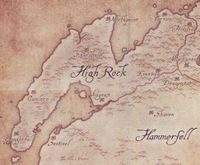
The province of High Rock is the ancestral home to the modern day Breton people, and by tradition the name High Rock originates from humanity.[47][48] Before them, there's evidence that a beastfolk population were High Rock's original inhabitants, though they did not build permanent communities, and what interactions they had with Men and Mer are unknown.[49] Considered a cursed and hostile race in the modern day, the dreugh are thought to have once had a great civilization that flourished around the Iliac Bay before the First Era.[50] Legends abound of the hill giants, a race of giants from Skyrim that migrated to the present day region of Rivenspire, bringing along their massive mammoths. Though they are no longer around, giant remains found within a cavern system in the region gives credence to this theory.[51][52][nb 3]
Bretons themselves originated from Nedes and Aldmer interbreeding[10] for centuries as far back as the Merethic Era.[11][12] Whether Man or Mer came to High Rock first is debated in scholarly circles: some believe that Nedic civilization and their Druid King were already established in the province when the Aldmer arrived,[11] while others claim that the Nedes arrived in High Rock afterwards, and encountered the elves gradually with a variety of reactions and outcomes.[53][49][UOL 4]
The Nedic ancestors of the Bretons were a people that survived in ancient High Rock by tapping into and nurturing nature.[13][18] They followed Y'ffre's True Way (later known as Druidism),[31] in which the eponymous god took the forefront of their faith. Under it, one is to lead a life connecting with and valuing the natural world.[54] Some reverence was also shown to the stars, especially the Ritual constellation.[18] These Nedes are known by the retroactive nomenclature, the Druids of Galen,[11][12][14][3] (or proto-Bretons)[UOL 2][13] and what would become their moniker is derived from a mythical "Galen", an entity or place which druids first came about.[13] Regardless of the origin, it is agreed that the True Way was born in High Rock.[55]
There is evidence of human settlements in High Rock dating back at least a thousand years before recorded history.[56] Archaeological excavations have dated the ruins of Nedic habitation to as early as ME 1000, predating Ysgramor by centuries.[53] The Nedes of Stormhaven had strained relations with the neighboring Orc clans, which regularly clashed with other Orc clans and their Nedic neighbors.[57]
The Aldmer that settled High Rock did so sparsely and in very specific locations,[UOL 4] and it is speculated that there was internal strife between the various Aldmer clans of High Rock.[UOL 5][58] The most successful of these settlers were from Clan Direnni,[49] who came to the province from the Summerset Isles in the Middle Merethic Era and captured the Adamantine Tower.[59][60] Some believe the Direnni were following their destiny to rule from Balfiera, while others believed that they were exiled.[61] The Direnni didn't enslave the Nedes as the Ayleids of Cyrodiil did; instead, they ruled them as a noble caste. The elves established a system of feudal vassalage over their new subjects and took Nedic concubines.[1][60] They inevitably interbred with their human subjects, producing Half-Elven children (also known as Manmer).[1][4]
The Direnni, Druids, and the Wyrd[edit]
The Druids of Galen led the new race when it first emerged,[UOL 6] as children begat from Elf-Nede relations were considered sub-Mer and not accepted by their Direnni parents. Instead, they were given privileged positions among the Nedes, which eventually led to a recognizable mixed-blood human caste dubbed "Bretons", from the Ehlnofex "beratu", meaning "half".[11][1] These Bretons were only allowed to marry humans, and over time, the Bretons' human features became more prominent than their elven traits.[1] Shortly after the Breton race emerged, Druidic spellcraft became the first truly Breton creation, and "druid" as a distinct identity was fully realized.[18][15] Though the term Manmer is archaic in the modern day, Breton druids embrace this heritage by still referring to themselves as such,[18][17] and believe in Breton's ability to enhance or perfect nature.[17] Indeed, the modern Breton has a natural affinity for environmental manipulation.[16]
Eventually, the witches of the Wyrd diverged from the True Way in a religious schism, ultimately driven away by what they called the "excesses of the Elves".[18] In druidic belief, mortals[18] were not meant to separate themselves from nature, as one can rejuvenate and enjoy Y'ffre's bounty through it.[62][63] While the druids revere nature, they were not keen to isolate themselves and worship the untamed wilds.[18][64] Therein lies the primary difference in culture between druids and the Wyrd: the Wyrd abandoned civilization in favor of living in the wilds,[18] and believe that they are nature itself: the forest, the plants and beasts within it, and even the weather.[65][18] In contrast, druids accepted what they interpreted as their "proper place" as people, and embraced the idea that civilization can coexist alongside nature.[18][64][63][66] The Druids of Galen and the Wyrd disapproved of each other's lifestyles: the druids found the ways of the Wyrd unsavory, and the Wyrd thought the druids were no better than city-dwellers.[66] Druids would much later practice self-isolation to varying degrees,[32][63][67] as a response to the historical encroachments and heartless deprivations that would await them.[18][64]
While the Aldmer maintained control of Tamriel, Clan Direnni coexisted peacefully alongside their Nedic and Half-Elven subjects.[53] The Direnni ruled largely through their Nedic clients,[UOL 4] while the "Meriphilic"[68] Druids of Galen used their fearsome magic to enforce their influence over early Bretons, and the Wyrd avoided politics altogether.[69] Some Manmeri devotional idols from this period depict Mara as an elven woman in a lover's embrace with a man, suggesting Aldmeri culture may have been welcomed with relatively open arms.[70] However, their comity would not last: localized groups of Bretons displeased with Mer butted heads with their Elven overlords long before they officially came to blows.[12]
First Era[edit]
The earliest written account of the existence of a Breton is from the late Merethic Era, which is the blacksmith Asterie Bedel, who is credited with the creation of the legendary artifact Chrysamere.[71] The history that followed would see the Breton peoples venturing out of High Rock and into other provinces. The sage and author Voernet was around during the year 1E 20, when they traveled to Artaeum to meet with Iachesis, the Ritemaster of the Psijic Order.[72] Archmage Gauldur who was a contemporary with High King Harald, became cemented in Nordic oral traditions despite an age-long campaign to erase his legacy.[73][74] During the Alessian Slave Rebellion, Alessia hired many Breton and Nordic warbands as mercenaries with promises of land and trade concessions. After the Alessian Cyrodiils achieved victory, the mercenaries that participated were assimilated into the Nibenese culture.[75]
Written in 1E 200, the Tamrilean Tractates speak of an early encounter between a Nord hunting party and the Bretons. The Bretons were scarcely recognizable as Men, and the Nords attacked them thinking they were another strain of Aldmeri. The Nords ceased their assault when one of the Bretons spoke in broken Nordic, and the hunting party brought word of this "newly discovered" race of Men back to Windhelm. The Nords believed the Manmeri from beyond the Reach were descended from human slaves taken during the Night of Tears. Indeed, High King Vrage made this his pretext for the First Empire of the Nords going into war, and his main priority in High Rock was to liberate the Bretons from their elven masters.[4] Vrage's initial campaign brought him as far as the Bjoulsae, but their progress was impeded by elven magic, and the elves were also aided in battle by many of their Breton vassals.[4] Though the Aldmer kept hold of their lands,[49] some sources claim that all of High Rock was conquered by the Nords[56] by 1E 240.[76] The city of Daggerfall was founded by the Nords[49] in 1E 246, and one of the first civilized acts they performed was a census of this city.[76][56] As a result of the Nords founding fortified towns along the coasts to support their pillaging parties, some of High Rock's cities aside from Daggerfall include ones such as Camlorn and Reich Gradkeep, which are Nordic in origin.[49]
Tired of outside influence, the Druids of Galen advocated for druidic governance of High Rock, resulting in them becoming a target of virtually every faction vying for control of the province.[68] The rising Direnni Hegemony saw them as a threat to Elven interests, and the Alessian Order persecuted the druids as they deviated from their religion.[18] Ultimately, they split from Bretondom around 1E 330. Following the guidance of Y'ffre's visions,[55] a song, or an Elder Scroll,[68] Druid King Kasorayn led somewhere between an estimated few thousand to a million druids on an exodus to The Systres.[55][68] A few remained on the mainland.[63]
When the Druids of Galen arrived to the Systres, the Draoife terraformed a barren volcanic island into a lush and verdant volcanic paradise and named it Y'ffelon. The druids then swiftly expanded across the archipelago into the three other islands,[77] sprouting life where it was once barren.[68] The dissolution of the Druids of Galen was brought about with the event known as the "three mornings of sail", where priest-navigators set out to sea on enchanted vessels outside the archipelago. Their outside experiences and their interactions with different races resulted in three sects developing, each with their own interpretation of Y'ffre's will; the Stonelore, Eldertide, and Firesong Circles.[63][68] Despite their separation, to symbolize their unity matters more and that they share the same goals, the druidic circles came to shaping knot-work into a triquetra,[78] a symbol that would become adopted by civilized Bretons.[79] Kasorayn himself took on the role of an observer after he helped establish the druids on the isle, and only intervened when necessary. The druidic monarchy ended after heretics from the Allwither Order murdered Kasarayn. The heretics are speculated as wanting to seize the Ivy Throne[58] to enact revenge on their former Elven oppressors back in High Rock.[80] Though the Allwither heretics were defeated,[58] prophecy would deem that the title of Druid King remain vacant for thousands of years.[81] The Druid King's symbology would disappear almost overnight.[64][82]
The Rise and Fall of the Direnni Hegemony[edit]
After much infighting between the Mer of High Rock over who would rule the province,[58] circa 1E 355, Clan Direnni established their Hegemony after they emerged victorious through political maneuvering and devious machinations.[76] However, some consider the Direnni's rule in the years leading up to its establishment as part of the Direnni Hegemony as well.[68][55][63] The Nord's holdings in High Rock were threatened and ultimately lost as a result of the War of Succession erupting in 1E 369,[56] which ended in 1E 420.[83] It is said that King Edward of Daggerfall and King Moraelyn of Ebonheart used the Horn of Summoning to expel the Nords from High Rock.[84] The historical fiction King Edward places Edward as being born after the Nords were expelled from High Rock, however.[85]
After gaining influence and purchasing the Isle of Balfiera in 1E 461,[86][87][88] Ryain Direnni led Clan Direnni to conquer all of High Rock by 1E 477.[76][87][89] Ryain and his Breton legions were supposedly the first to sack the Orc hold of Orsinium,[87] though whats known as the "First Orsinium" is usually dated much later to the ninth or tenth century of the First Era.[90][91][92] As the Direnni Hegemony expanded geographically, the elves, who were few in number, passed increasing powers of administration to the Breton caste.[1] Clan Direnni was inspired to outlaw the religion of the Alessian Reform by Rislav Larich's victory against Emperor Gorieus, and began pushing into Imperial territory.[89] The timeframe between 1E 480 and 1E 482 would see a coming conflict with the Alessian Order. Seeing the threat the Order posed, Aiden Direnni signed the Rights Charter out of necessity, in efforts to muster troops for the coming conflict.[87] Aiden Direnni's army defeated the Alessians on the 8th of Sun's Dawn at the Battle of Glenumbria Moors in 1E 482 with the assistance of Breton knights[35] and the last Ayleid king.[93] The Bretons of the Glenumbra Moors celebrate the Day of Release to commemorate this victory.[94] A popular song from the Second Era memorializes the Bretons' role in turning the tide against the Alessian generals, and commemorated the Direnni clansmen who were instrumental in defending High Rock.[95]
Thoroughly spent, the Direnni withdrew to Balfiera and their hegemony fell circa 1E 498.[1][76][UOL 7] With most of High Rock free from Elven control by 1E 500,[4] the Breton kingdoms began establishing themselves around this time,[96] The Bretons' rise to prominence in High Rock initially started through villages being founded in tactical locations, such as Wayrest, which started as a fishing hamlet on 1E 800.[92] Nordic cities such as Camlorn became Breton due to assimilation from the growing Breton population as opposed to conquest. Over time, the emerging Bretons absorbed the remaining Nordic population in High Rock, and the land would be definitively Breton by the end of the First Era.[49]
Though the province was in Breton hands, it was by no means a cohesive nation. Clan Direnni's retreat to Balfiera left a vacancy in the way of a united government, and High Rock was left with a hundred fiefdoms to squabble over power.[49] The elf-blooded nobility of Greater Bretony took up the mantle Clan Direnni left behind, maintaining the feudal hierarchy their elven predecessors forged and placing their noble families, the oldest of whom the elven blood flowed strongest within, in the position of aristocracy. The new noble class, consisting of highborn Bretons, justified their ascension to aristocracy and the preservation of the peasant class by disassociating themselves from their elven heritage. The Bretons vilified the Direnni, and redefined themselves around the notion that they were not elves. The Breton nobility fabricated a history of noble resistance to Direnni rule to suit the narrative that Breton cultural identity had no elven roots. In time, a merchant class sprouted and thrived, trading around Tamriel's coasts.[1] In addition to the conflicts over borders and crowns, the Bretons were left to deal with the encroachment of the wilds upon their settlements: the Direnni renounced their covenant with the Earthbones after their retreat, which legends claim they did out of spite. This pact protected Direnni roads and townships from the forest and the beasts that inhabited it.[47]
During the late-fifth century, violence against the Direnni began under King Festrien Spenard I. Supported by vassals from House Aurmine, the despot king's Knights of the Pale Order slaughtered the Direnni wholesale during the latter years of their flight from High Rock. Knights of the Pale Order kept lists of Direnni warriors and magisters they slew.[97] In spite of the vilification of the Direnni and disassociation from their elven heritage, at least some Bretons would continue to emphasize their elven blood.[98]
The earliest encounter the Bretons have with the Redguards is through their predecessors, the Yokudans. A specific tribe, the Silverhoof Horsemen, are perhaps the earliest to come to mainland Tamriel. Their arrival in High Rock was most opportune for them, as the Direnni Hegemony was recently dissolved, and the Breton kingdoms still needed time to establish themselves. The Silverhoof Horsemen became "Bretonized" due to interacting with their neighbors over the centuries while retaining significant elements of their original culture.[96]
Bretons on the World Stage[edit]
By the time the Druids of Galen fled the mainland circa 1E 330, the Breton peoples had already encountered the Dwemer, though such occurrences with them were minimal.[99] After the First Council was founded, new trade opportunities opened up for the Bretons circa 1E 420, when the self-exiled Clan Rourken relocated to Volenfell in Hammerfell, south of High Rock.[100] Set around the time period before the arrival of the Redguards to Tamriel, the historical fiction King Edward showcases the negative attitudes the people of High Rock had towards the Dunmer's predecessors, the Chimer.[nb 3] Various stereotypes showcased them as thieves and kidnappers, with myths claiming that they sprout from the ground,[85] culminating with them being banned from Daggerfall for a time.[101]
Eventually, the differences in the beliefs of the three major Systrean drudic circles nearly led to conflict. This however was stopped by the appearance of a common enemy, the Sinistral Elves, who arrived on the Systres circa 1E 660 to flee the Yokudans. Their invasion was temporarily halted when Y'ffelon's volcano of Mount Firesong erupted somewhere around 1E 668. Regardless, the Sinistral Elves took over the archipelago, and the druidic circles were forced into hiding. With the coming of the Yokudan Ra Gada in 1E 785, what remained of the Elves were purged, and the Yokudans quickly left the island to go eastward. In the end, only the druids remained.[102]
The Yokudans that the druids encountered on their way eastward were just part of the first "warrior wave" that sought glory in Hammerfell.[103][102] The second was composed of the Tavans, who came around the time of Yokuda's sinking in 1E 792.[104] Hammerfell was a holding of Clan Direnni during their Hegemony,[76] and was known as by its Aldmeri name of Hegathe.[100] The Tavans kept the Aldmeri name for the harborage they captured from the beastfolk, and used it as a staging ground during their conquests.[100][105] Before their arrival, the Bretons and the Elves established an outpost at what is now Sentinel, in order to protect fisherfolk and seafaring merchants from inland Orcs and other hazards in the desert.[100] The warrior wave that came after the capture of Hegathe was led by Grandee Yaghoub. They quickly discovered and established control over the locals' port with little if any opposition. Yaghoub conscripted the locals to serve as masons and servants in the building of his new palace, Samaruik, and the rest of the city.[105] The kings of the Ra Gada continued to raid Breton coastal cities and trading vessels,[106] and the Cyro-Nords from Colovia who plundered the Iliac Bay annually were pushed out by them.[107] The descendants of the Yokudans, the Redguards, would later become established as historical enemies to the Bretons.[16]
Orsinium was built on the boundary between western Wrothgar and Rivenspire in the ninth or tenth century of the First Era.[90][91][92] King Golkarr of the Orcs amassed an army and was determined to seize control of the Bjoulsae River,[108][109] upon which the nomadic Breton Bjoulsae River Tribes lived.[110] They intended to force Wayrest to pay to regularly use the river for travel and trade.[109] In 1E 874 the Bangkorai Garrison prevented Warlord Thulgeg's army of Orcs and Goblins, who were fleeing Hammerfell to seek refuge in Orsinium, from entering the province through Bangkorai Pass.[91][111] 1E 948, King Joile of Daggerfall sent a letter to Gaiden Shinji of the Order of Diagna, proposing a joint attack on Orsinium. Joile cited that the Orcs were raiding along the Bjoulsae and impeding traffic to the heart of the land as reason enough to make war against the Orcs. Agreeing to provide aid, an alliance was formed between the Order of Diagna and the armies of Daggerfall and Sentinel. The armies amassed and began a 30-year long campaign for the destruction of Orc's homeland known as the Siege of Orsinium.[92][90] In that time, King Joile planned to betray the Redguards and invade Hammerfell. Joile and his Reachman general Mercedene enacted a plot to kill Gaiden Shinji and Orcish hero Baloth Bloodtusk, which succeeded, despite the efforts of Daggerfall's own Knights of the Dragon to stop the attempt and their defeat of General Mercedene.[112] In 1E 973, Joile's invasion of Hammerfell proceeded, but he was stopped by the Ansei warrior Makela Leki at the Bangkorai Pass.[113] The Siege of Orsinium finally ended in 1E 980 when the allied forces breached the city's defenses, overran it, and razed it to the ground.[90]
The Bretons experienced a period of economic expansion after they razed Orsinium, for the Bjoulsae River region was greatly opened up for trade. The kingdom of Evermore was founded by the Bjoulsae River Tribes,[114] and Wayrest also established a presence on both banks of the region. The Masconian Trade Way was formed by the hard-working traders and merchants of the Bjoulsae River. Not only did it bring about a decline in piracy, it also led to a great expansion of the Bjoulsae's trade and community.[92] One such factor that contributed to this was Daggerfall's ivory trade, which originated with ivory plundered from Orsinium following its sacking.[115] The uneasy truce between the Bretons and Redguards that resulted from Orsinium's perceived threat morphed into economic relations between the two races.[116]
The First Empire[edit]
In 1E 1029, Empress Hestra pursued the Gray Host from Verkarth to the Bangkorai Pass, where the Bretons held the line and fractured the undead forces, easing the Empire's hunt. Hestra was impressed, and offered High Rock admission into the First Empire, which they accepted.[91] Thus, the Bretons joined the Empire of Men and accepted Alessia's Eight Divines.[1]
The Thrassian Plague that was unleashed by the Sload against Tamriel caused devastating losses, with the population of the Iliac Bay in particular being halved.[56] Seeking vengeance against the Sload on behalf of Tamriel, the Colovian King of Anvil, Bendu Olo, was granted an Imperial fleet by the emperor of the Alessian Empire,[117] and looked to other races to bolster the size of the fleet. The Bretons lent their sailors and warships to help in the formation of this fleet, which became known as the All Flags Navy.[118] Sometime around 1E 2243, the Navy arrived in the Systres Archipelago, where they established a naval base and shipyard within High Isle's Gonfalon Bay, which dwarfed others created for this conflict.[117] Some Bretons who were among the initial fourteen ships that arrived to form the basis of the All Flags Navy were Captain Lisolda Davaux and the King's Jest, Renwic Moorcroft and the Pristine Halberd, and Coin-Baron Nemic Santerre and the Silver Lantern.[119] Bendo's call also attracted knightly figures such as Lady Joslin Garick and Baroness Belene Chatillon.[120][121] The local Stonelore Circle also lent a ship and druids for the coming conflict.[122] After various skirmishes evolved into the eventual final assault on Thras in 1E 2260. The entire landmass was sunk into the ocean, with half of the fleet being caught within the giant whirlpool. The remaining influential figures returned to the Systres, where these representatives of each race signed the Concordat of Fraternity on All Flags Islet, in hopes to bring about peace and cooperation.[117]
In Elsweyr, the Thrassian Plague caused the clan structure of Pellitine to collapse. The people took on the social and political structures of other lands, especially that of the Bretons and Imperials.[123]
Angry merchants from Wayrest called their fellow Bretons to secede from the Alessian Empire circa 1E 2300, citing prejudice against elven heritage. They emphasized the increasing Imperial tithes to support their position.[124] High Rock formally reasserted its independence in 1E 2305 in response to the Alessian Order's excesses.[91] Despite resenting High Rock's secession from the Empire, the Alessian Order did not intervene until King Desynan of Skingrad and Queen Margert Gardner of Wayrest planned an arranged marriage between their children. Fearing a dynastic alliance between High Rock and Colovia, Arch-Prelate Zirnius who forbid the union, sent out his legions to punish the Colovians after Desynan circumvented Zirnius' ruling by appointing someone to officialize this marriage. This conflict was initially "anarchy, local uprisings, and shifting alliances" that were contained within the Colovian Estates, but it later shifted to Breton lands within the Iliac Bay.[125] The Legions of Piety and Grace were sent to Bangkorai under Abbot-General Priscus Mactator to suppress the Bretons, but the Imperials fell at the Bangkorai Garrison.[91] This loss would embolden the rebelling Colovians, officially kickstarting the War of Righteousness in 1E 2321.[48][nb 5]
Although the Systres were claimed by Bendu Olo as an extension of Colovia after the All Flags Navy's victory over the Sload, the financial costs of the war caused the archipelago to be sold by the Colovian Estates to High Rock Coin-barons Circa 1E 2327. With this acquisition, Duchess Martinne Guimard became ruler over the archipelago, and in 1E 2328, named the largest island High Isle in honor of High Rock. The true value of this purchase was that the land was "an untouched cradle of Breton history", with Druidism alive and well, and Breton culture at the forefront thanks to the Breton laborers that stayed behind after the assault on Thras. To the delight of the Systreans, their archipelago remained untouched by the conflict of the War of Righteousness.[48] The Alessian Order's heavy losses in the west forced them to tax and conscript people from eastern Cyrodiil, causing angry Nibeneans to rebel and slay the Arch-Prelate and destroy the Order's great cathedral at Lake Canulus. With no leadership and income, the Alessians fighting in High Rock abandoned their invasion.[125]
High Rock was independent once more, but the secession was not a clean break. The Alessian collapse struck the stubborn Bretons harder than the other races, as they had no unified governing structure. Warring fiefs would rage across the peninsula in the coming centuries, and pretender-kings attempted to assume control in place of the Alessians.[126] Additionally, the War of Righteousness halved the population of the Iliac Bay a second time.[56] The Systres remained in Breton hands despite later changing ownership from House Guimard to House Mantel. In 1E 2484, Mount Firesong erupted once more, devastating the island and killing many of the inhabitants. What changed was a shift of political power, for those in the lower classes were most affected by the starvation and illnesses. What followed was a renaissance of Druidism, for it was the Stonelore Circle that pulled the city folk out of the brink of death, helping them in the creation sprawling pastoral and agricultural operations. This time period was referred to as the Green Years.[127]
The Second Empire[edit]
The first appearances of the Akaviri in Tamriel are that of pirates which are now assumed to have been scouts for eventual invasions on the continent.[104] They held a hostile presence in High Rock's First Era, where pirates and raiders established themselves to the islands to the west of Wayrest around 1E 800 and were counted as enemies to the Bretons at the time.[92] Legions of Akaviri raiders invaded northern Tamriel around 1E 2700,[128] and were among the reasons the population of Wayrest moved into the Gardner's walls for protection in 1E 2702.[92] High Rock was weakened by the Akaviri invasion, with the population of the Iliac Bay being halved a third time. It is said that if Daggerfall had not been hardened and fortified through wars in its first thousand years of existence, the Iliac Bay would have been Akavirian in the present day.[56]
The Second Empire was established in 1E 2703 after Reman Cyrodiil suppressed the Akaviri invasion of Tamriel at the battle of Pale Pass.[107] With the Akaviri's number and their tactics boosting his ranks, Reman continued on to pacify the rest of Tamriel.[128][107] An alliance known as the League of Unrest being created between Daggerfall, Wayrest, and Balfiera in an effort to stop Reman's forces, but they were defeated and High Rock was absorbed into Reman's empire.[129] In an effort to make Cyrodiil a cosmopolitan land, Reman I was inspired by High Rock and incorporated elements of the province into his own.[130] Though conquered, High Rock's virulent sectarianism would remain intact.[4]
The distant shores of the Systres were also affected by Reman Cyrodiil's ambitions. In 1E 2704, the Reman Empire reclaimed the archipelago, ending the Green Years when they reinstalled Breton Coin-barons as the rulers.[131] The High Rock Coin-barons committed various injustices when they utilized their merchant fleet to move illicit goods. The Coin-barons were also involved in slavery, which was a fact of life of Breton culture of the time. In the Systres, they established a slaver fort on Amenos.[UOL 8][132] On High Isle, the Spire of the Crimson Coin stands as the best preserved example of their excesses, where many grim and debaucherous celebrations took place.[133][134]
As part of the Second Empire, High Rock's soldiers participated in the 80-year Four Score War against Morrowind. In 1E 2920, the final year of the War and First Era, a Breton man named Cassyr Whitley of Dwynnen defected from Emperor Reman III's Imperial army and spied on the Dunmer's behalf. After Whitley's faulty information cost Morrowind the fortress of Ald Marak, he returned to High Rock, where he crossed paths with Dunmeri exile Turala. After Turala's coven and child were lost to an Orcish raid, Whitley falsely convinced the woman that the attack was the work of assassins in the employ of Duke Brindisi Dorom of Mournhold, prompting her to summon Mehrunes Dagon in a misguided act of revenge.[135]
Second Era[edit]
During the Reman Dynasty, High Rock was possibly the most prosperous and stable of the provinces within the Second Empire,[1] and would continue to benefit once it was replaced by the Akaviri Potentate at the start of the Second Era. Concurrent with the rule of Versidue-Shaie, urban Bretons started systematically organizing themselves alongside the hierarchy the Mages Guild sometime after its founding in 2E 230. The Mages Guild became a formidable force within High Rock,[4][7] but it was not officially sanctioned within the Second Empire until the Guild Act was signed by Versidue-Shaie in 2E 321. The Guild Act also standardized regulation of trade and transactions across the Empire, and was adopted as de facto law across Tamriel, including in High Rock.[136]
Circa 2E 312, the Bretons on Betony were attacked by War Chief Yzzgol and his Seamount Clan. King Renwic attempted to defend his island with necromancy and an ancient Ayleid relic, but failed. Yzzgol exterminated the Bretons and renamed the island Betnikh.[137][138] King Casimir II of Wayrest formed an alliance with a Dragon named Nahfahlaar some time during the second century, which was ended by the Dragonguard in 2E 369.[139] Circa 2E 428, High Rock was plagued by a werewolf crises that would become known as the Curse of the Crimson Moon, leading to the creation of the Order of the Silver Dawn, which is dedicated to hunting werebeasts.[140]
The Interregnum and the Three Banners War[edit]
The Second Empire collapsed with the assassination of Akaviri Potentate Savirien-Chorak in 2E 430, marking the start of the Interregnum. Left without a Dragonborn Emperor, the Empire of Cyrodiil was continually passed back and forth among petty warlords for centuries. High Rock fared much better than the other provinces at this time, despite being fractious in nature.[49] Another Orsinium was accepted as a territory of the Second Empire during Savirien-Chorak's reign,[109][141][136] and Frostbreak Fortress was built to help defend it during that brief period.[142] After the Second Empire's fall, Orsinium lost its status and protection as an Imperial territory, resulting in another sacking of the city in 2E 431, an assault which was spearheaded by the Bretons of Shornhelm.[109][143] The Bretons seized control of the land and scattered the Orcs across northern Tamriel.[144][145]
In 2E 542, the Reachmen under Durcorach the Black Drake invaded High Rock, sacking Evermore and Camlorn. They were defeated at the gates of Daggerfall by Emeric of Cumberland, which led to the formation of the first Daggerfall Covenant, signed by the kings of Daggerfall, Camlorn, Shornhelm, Wayrest and Evermore. In 2E 563 Emeric became the king of Wayrest. Three years later, king Ranser of Shornhelm invaded Wayrest, angry at Emeric for rejecting his daughter's hand to instead wed Maraya, the daughter of King Fahara'jad. He was defeated at Markwasten Moor by the forces of the Covenant with the help of the Orcs, who were promised to have Orsinium returned for their aid.[143] The Orcs aiding King Emeric would push Ranser over the edge, and he ordered his Spymaster to round up many Orcs in Rivenspire to be interrogated and executed. The Spymaster would end up murdering hundreds of innocent Orcs during the course of Ranser's War.[146][147]
These events led to the formation of the Greater Daggerfall Covenant, which was an alliance between Emeric, the Redguard king Fahara'jad and the Orcish king Kurog gro-Orsinium.[148] King Kurog demanded restitution for the ivory looted by the Bretons during the Siege of Orsinium as part of his terms for the Orcs to join the Daggerfall Covenant.[115] Trade flourished under the alliance, making the Covenant an economic powerhouse.[149] The Covenant later fought in the Three Banners War during King Emeric's bid for the throne of Cyrodiil.[148] The kings of the Daggerfall Covenant looked to Reman as a model Emperor, and saw themselves as the spiritual heirs to the Second Empire.[144] Focused on "restoring the glory of Reman's legacy", the Covenant cited its focus on freedom, worship of the Divines, and primacy of trade as reasons it was meant to be the center of Cyrodiil's power.[149] Race relations between the Bretons and Orcs improved during the Covenant's existence,[150] despite the persistence of anti-Orc sentiment.[151] The Direnni elves were also accepted within the Covenant's borders.[152]
Fate of the Systres Archipelago[edit]
The Ascendant Order gained traction as a pan-Tamrielic movement[UOL 9] thanks to the influx of common folk across Tamriel joining, whose lives were ruined by the destruction caused by the Three Banners War. They were drawn in by leaders of the faction, the Ascendant Lord and his Ascendant Magus, who promised them that they would bring down Tamriel's tyrants who grow richer and powerful at the expense of misery and bloodshed.[153] Breton-influenced, the Ascendant Order likened themselves to a knightly order, though most legitimate Orders thought of them as nothing more than well-armed fanatics.[UOL 9] They infiltrated nearly every level of Breton society,[154] and had established the Systres Archipelago as their main base of operations.
In truth, the leaders of the Ascendant Order were nobles, utilizing disgruntled commoners to fulfill their goals. The Ascendant Magus was Count Damard of House Dufort, while the Ascendant Lord was Lord Bacaro of House Volorus from Cyrodiil. Bacaro's partner and children were killed during the conflict of the Colovian Revolt, and when the Three Banners War came around, he had created the Society of the Steadfast to serve as a humanitarian organization.[155] Lord Bacaro later settled in his holdings on the Systres and overtime, built goodwill through his Steadfast Society. He then planned to leverage his reputation to lure the major players responsible for the Three Banners War to their deaths. The result was the Ascendant Order becoming a terrorist organization that failed to assassinate these major players when they visited High Isle for peace talks initiated by Bacaro.[156][63]
Concurrently, the druids on Galen were involved in a civil war orchestrated by Bacaro's unwitting pawn, Archdruid Orlaith of the Firesong Circle. When Orlaith failed to become the Druid King and forcibly unify the druids under one banner, Bacaro took matters into his own hands. Ultimately, Bacaro was also a member of House Merchad through his mother's bloodline, a noble house with ties to the last Druid King, Kasorayn. As its last living descendent, he felt it was his birthright to claim the Ivy Throne of the Druid King, and use it to replace the corruption of the Ruby Throne.[157] The Vestige confronted Bacaro at Mount Firesong, where he had ascended into a false Druid King. Utilizing his newfound power, Bacaro enslaved the dormant spirit of the volcano, which was capable of decimating Tamriel's armies.[158] However, Volorus was defeated, saving the archipelago from destruction.[159][160]
What followed afterward was a more unified Systres Archipelago. The feudal Bretons and the druids that inhabited Galen began talks to build better relations, and the mending of wounds between the feuding noble houses of High Isle and Galen began.[32] It is unknown what became of the Bretons of the Systres, as the isles were later considered to be Hammerfell's territory.[nb 1]
The Third Empire[edit]
During the Tiber War, a Nord-Breton alliance captured Sancre Tor in 2E 852. General Talos recaptured the city and integrated the Nordic forces, impressed by his thu'um, into his own army.[107] He executed the Breton leadership, and variously executed, enslaved, and sent the Breton forces back to High Rock.[161] Those Bretons who remained sought to counter Talos with Reach-magic, and in 2E 854, entrusted a Reachman to assassinate Cuhlecain and his general. Talos survived the attack, and went on to found the Third Empire[107]—though The Arcturian Heresy claims Talos himself slew Cuhlecain, and placed the blame on his enemies.[162]
At some point in their history, the Bretons were ruled by witch-kings.[163][UOL 10] Talos, now known as Tiber Septim, would easily conquer the squabbling Breton kingdoms, but would find it impossible to truly squash the sectarian conflicts between them that hampered trade and prosperity.[4][49] Septim opted to entrust a governor of his choosing to end the feud between High Rock's witch-kings, which was a successful endeavor.[164]
Third Era[edit]

The Dream of Kasorayn foretold of druids retaking their place on Tamriel and a possible future where the druidic circles reestablish themselves as the Druids of Galen after uniting under the banner of a new Druid King.[UOL 11][UOL 12][166][158] Attempts to forcibly reclaim the past glory of the druids led to bloodshed during the First and Second Era,[58][166] which prompted an outlook to instead look into a future where druids may not require a king or a prophecy to make the world a better place.[32] Indeed, the Druids of Galen may not be resurrected, for Kasorayn's dream may simply be a metaphor. Druidkind should live life like it is close at hand, however.[158] It is unknown what parts of the prophecy came true, but by the fifth century of the Third Era, druids were once again present in the regions surrounding the Iliac Bay.[165][UOL 13] "By the ArchDruid" is a common exclamation by Bretons of this era.[167][168]
Since most Emperors in the Third Era were Bretons, or had spent their youth in High Rock, Bretons were generally supportive of Imperial rule, but were often disgruntled by its inefficacy at protecting them from violent conflicts.[169] By the Third Era, there were eight major Breton kingdoms in the province of High Rock: Daggerfall, Camlorn, Wayrest, Shornhelm, Northpoint, Evermore, Farrun, and Jehanna.[170]
The decentralized nature of Breton society has also given it surprising resilience during times of upheaval or chaos.[49] One of the best examples of this was illustrated during the defeat of the Camoran Usurper, when four of the smaller Breton city-states—Dwynnen, Kambria, Phrygias, and Ykalon—led a united force of Bretons that managed to halt the Usurper's inexorable northward advance and finally defeated him in the Battle of Firewaves in 3E 267.[169] Baron Othrok had already gained fame for his defeat of the Lich of Castle Wightmoor during the Battle of Wightmoor fourteen years prior, leading to the founding of the modern barony of Dwynnen which would eventually grow to be one of the more powerful city-states in western High Rock.[169]
Other wars which occurred in High Rock during this Era included the War of the Bend'r-mahk in 3E 397, in which Skyrim conquered land in the east including the Kingdom of Jehanna. It later came to light that Jagar Tharn was behind Skyrim's aggression, and when Emperor Uriel Septim VII regained his throne following the Imperial Simulacrum, efforts were taken by the Empire to restore the damage caused by the war, and the Bretons presumably regained control of Jehanna at this time. At the other end of High Rock, the War of Betony was fought between Daggerfall and Sentinel over the island of Betony in 3E 405. The Battle of Cryngaine Field resulted in Daggerfall's victory, though at the cost of King Lysandus of Daggerfall's life. His son and heir Gothryd was crowned the new king of Daggerfall after the war.[49]
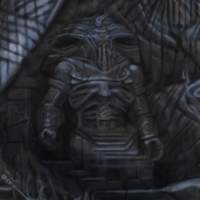
On the 7th of Frostfall in 3E 417, as a consequence of actions undertaken by the Agent, the Warp in the West occurred. The roughly two dozen city-states comprising southwestern High Rock were suddenly, forcefully, and mysteriously united into two kingdoms: Daggerfall and Wayrest, with Orsinium taking control of part of the Wrothgarian Mountains in central High Rock.[171][172] The Warp in the West reduced the amount of squabbling kingdoms in High Rock from "a hundred" to about five; according to Imperial sources, it was the most unified High Rock had ever been.[49]
Fourth Era[edit]
In the early Fourth Era, following the Oblivion Crisis and the destabilization of the Third Empire, the combined forces of Hammerfell and High Rock sacked Orsinium, leading many Orc refugees to flee east into Skyrim.[173]
High Rock was still part of the Empire when Titus Mede II ascended the throne of Cyrodiil in 4E 168. High Rock assisted Hammerfell during the Great War. The Third Aldmeri Dominion took Hammerfell's southern coastline, leaving Hegathe the lone surviving state. Those who survived the March of Thirst joined Legion reinforcements from High Rock in northern Hammerfell in 4E 173, and the Dominion suffered losses in the province soon after. The Dominion withdrew from the Redguards' home in 4E 174. Forces comprised of Redguards, Imperials, Nords and Bretons participated in the Battle of the Red Ring in 4E 175. It was the climax of the war, and the last major conflict to occur before the signing of the White-Gold Concordat.[174]
In 4E 188, King Barynia of Wayrest was overcome by paranoia when rumors of conspiracy reached his ears. He purposely left his city vulnerable to outside attacks, hoping his enemies would be killed in the chaos. His actions led to the sack of Wayrest by Breton corsairs. The city's nobles hired an assassin from the Dark Brotherhood amid the conflict, though Barynia's fate is ultimately unknown.[175] The corsairs raided and destroyed the Dark Brotherhood sanctuary hidden in Wayrest,[176] and departed the ruined city in the aftermath of their incursion.[175]
Circa 4E 201, the Stormcloaks looked to their neighbors in High Rock for aid in the midst of the Skyrim Civil War. The Bretons, who had good relations with the Empire, refused to respond to the Stormcloaks.[177]
Culture[edit]
Bretons are an intelligent, individualistic, energetic, pragmatic, and humorous people.[UOL 14][178][92] They are said to enjoy intellectual pursuits; they often have an affinity for anything related to logic and ordered complexity.[24] Their love of knowledge and affinity for commerce drives them into a host of careers, including trading, the military, sailing, medicine, textiles, manufacturing, writing, theology, philosophy, banking, all kinds of artistry, and other scholarly pursuits.[92][72][179][180][181] The Invisible College of Daggerfall is one of Bretic scholarly institutions.[182] Espionage has also proven to be one of their strong suits; Breton double agents, assassins, and spies have turned the tide of wars throughout recorded history.[107][183][184][185][186] Bretons value the principles of freedom, praising it in their tavern songs,[187] and propaganda,[188] however, this only extends so far in practice.[188] In 2E 582, the people of Evermore were allowed to freely criticize Queen Arzhela and the royal family,[189][190] while using excessive profanity in the presence of nobility in High Isle was grounds for being charged.[191] In the Third Era, a prolific bard and poet Darius Shano is also said to have criticized nobility, commoners and the Divines alike, receiving much scorn, but only being executed after ridiculing Tiber Septim.[192]
Society[edit]
Politics[edit]
- "You think politics here are something? Well, we Bretons invented politics." — Anton Virane[9]
High Rock is segmented into city-states, encouraging petty nationalism and infighting between the kingdoms that span the region. Most Breton cities are sprawling trade hubs, with society being separated into social strata. The poor peasantry lies at the bottom of the hierarchy. Above them is the middle class, comprised of merchants and artisans, while the nobility and ruling families sit above them all. Additionally, there are the many autonomous knightly orders and the small magical elite, which considers itself above the others.[7] The jockeying for power among the various monarchs and powers of the Iliac Bay region is a deeply ingrained and even cherished part of Breton culture.[4] Breton society is fractious and quarrelsome, but internal conflict all but seems to disappear when their way of life is threatened by outside forces.[7]
Breton's largely agrarian and feudal society, as well as their obsession with nobility, status, and lineage, is shaped by their days as vassals of Clan Direnni.[19][1][11] Bretons borrowed and modified their Elven ancestor's feudal system to suit their needs, removing the aspect that forced people to stay in the same social class for their rest of their lives.[11][UOL 15] Indeed, their outlook is shaped from breaking free from their Elven masters and taking High Rock for themselves. Thus Bretons live lives of excess and believe in upwards mobility to the extent that even those at the very bottom of the social ladder feel like they can always aspire to become better and advance to the top of the social ladder.[UOL 15] Despite this, there is still however a sense of elitism and otherism in Breton society. Some nobles may look down at common folk as inferior to them.[193][194]
Though Bretons of lower status have several paths to prosperity, becoming a nobleman by performing quests and services to curry favor with various rulers is considered the best way, which has created a cultural "quest obsession" among young Bretons.[4][195] The desire to find some great opportunity for fortune and glory has made Bretons venture all over Tamriel, even to such remote locations as Thirsk on the island of Solstheim, where one adventurous Breton once earned the position of chieftain.[83][196][197]
Peerage[edit]
- "Find a new hill, become a king" — Breton Proverb[4]
Across High Rock, traditions of the peerage differ slightly from region to region. The base rule of the eight kingdoms is that if a woman is ruling one of these areas, she is called the Queen. The husband of a Queen and the wife of a King is not necessarily of equal rank – they may not be Kings and Queens themselves. Their children are Princes and Princesses. Their grandchildren are also Princes and Princesses. If a male ruler dies, his wife takes the title Dowager Queen, providing there is not a Dowager Queen already. In the Kingdom of Daggerfall, it is permissible for there to be two persons with the same title. If a female ruler, who does not share rank with her husband, dies, there is no male equivalent to the word Dowager. Widowers of Queens usually take another title, either a lesser family title or one given by their children. There have been few men in the history of High Rock who have fallen from being addressed as King to being addressed as Mister at the death of their wife.[170]
Other regions in High Rock are ruled by Dukes and Duchesses, Marquises (or Marquesses) and Marquises (or Marchionesses), Counts and Countesses, Viscounts or Viscountesses, Barons or Baronesses, and Lords or Ladies. This is theoretically listed from highest to lowest rank, but the ruler of a territory outranks all other nobles, regardless of title.
Counts usually enjoy less autonomy than dukes and duchesses, as their territories are subservient to the duchies they are part of. However, they serve as vital links to guilds, churches, and scholastic organizations that might otherwise receive less attention from the duchy's rulers. Beneath counts and countesses, peerage hierarchy flattens considerably. Barons and baronesses stand above most, but these titles rarely carry robust land rights. Instead, they serve as titles of honor, granting the noble certain privileges at court. Dignitaries should address barons and baronesses as "my lord" and "my lady" respectively.[198]
Dwynnen, for example, is a Barony, and the Baron or Baroness of Dwynnen outrank any other noble in that territory, even Dukes and Counts. In theory, (again, this may not be the case according to local custom) the eldest son or daughter of a noble takes their parent's highest family title below their parents. Thus, the Duke of Northmoor, who is also the Marquis of Calder, had a daughter who became the Marchioness of Calder.[170]
Kings and Queens are always addressed as "Your Majesty" in conversation; Dukes and Duchesses, "Your Grace". All other rulers may be addressed with their title and name, or Lord or Lady and their name.[170]
One way of telling who is in charge of a region is to pay some attention to the names of taverns and shops in a region. By tradition, many of these are called names such as "The Duke's Fox" or "The Lady's Provisions." This, more often than not, is the title of the ruler. If the shop's name is, for example, "Lady Annisa's Provisions" or "Lord Boxworth's Fox," that is probably the name of a local titled merchant, not the ruler. A store with an unnamed ruler's title has probably been around for some time, and does not bother to change its name with the new name of the ruler.[170]
In High Rock where warfare between kingdoms accounts for much of the provinces' history,[6] there is only one recorded High King. Emeric of Cumberland managed to claim this supreme leadership as a result of being the architect of the Daggerfall Covenant, and after all the city-states of northwest Tamriel swore loyalty to the Covenant's Royal Council.[144] The various monarchs of High Rock were bound to him via trade agreements,[7] which included "dozens of compromises and carefully negotiated provisions".[144]
Role of Magic in Breton Society[edit]
- "You Bretons have a reputation for mystical aptitude, but I would argue that the cost of that success has been a lack of lasting impact on the greater magical community. I could find numerous instances of Mage So-And-So making a splash with war magics for a few decades, and then dying. Or a great divinator prognosticating portentous events, and then dying. Breton mages burn brightly but briefly, I suppose, a sad commentary on the lifespan your uncaring gods have gifted your people." — Divayth Fyr[27]
Bretons are known to be inventive wizards.[6] Magic permeates throughout all of Breton society, from the serf all the way up to the king.[UOL 3] Though no two mages weave their spells in exactly the same way,[199] the average Breton mage is said to perform "flamboyant gesticulations" when spellcasting.[200] Some Bretons are born with innate gifts for unique kinds of magic, such as thaumavocalism.[201] Due to the innate magical ability of Bretons, children are tested for their magical potential at an early age, and those who pass enter apprenticeship programs funded by the Mages Guild or independent sponsorships.[4] Children are known to practice illusion spells on each other in the streets of cities such as Daggerfall.[202] In more remote regions, such as Glenpoint and the Wrothgarian Mountains, witches and medicine men, barely distinguishable from Orcish shamans, hold sway over the superstitious peasants with feats of untutored, but often impressive, magical ability.[4] Many use their magical talents to earn success,[4] such as undertaking an ancient Breton tradition by taking on the role of a court mage.[33] Not much is known about the magical elite that sit right below the ruling families in the social hierarchy, but these gifted see themselves above the rest.[4][7][5]
Subcultures[edit]
Breton culture, despite its seeming homogeneity, is differentiable in each of High Rock's kingdoms due to the many subcultures of the regions of High Rock. Many clans inhabit regions such as Greater Bretony, the Dellese Isles, the Bjoulsae River Tribes, and traditionally the Western Reach.[4][5]
Bjoulsae River Tribes[edit]
- →For more detailed information, see: Bjoulsae River Tribes
The Bjoulsae River Tribes (also known as the Horse-People of the Bjoulsae River, the River Horse Bretons, or simply the horsemen) are the indigenous groups of tribal Bretons that live in the Bjoulsae River region. While information on them is scarce, the horsemen are a nomadic, primitive folk that wear fur armor, bone necklaces, and turbans. As the name suggests, they are known for their horses. Their battle strategies and tactics are described as straightforward, which is the "way of the horse men", in the book The Mirror. Their greatest legacy is the modern-day Kingdom of Evermore, which was founded in 1E 983 after they helped suppress Orsinium, which opened trade through the Bjoulsae River region.
Druids[edit]
- →For more detailed information, see: Druids
Druids (also known as vinebeards) are children of the land whose kind have their origins in ancient High Rock. They are practitioners of Y'ffre's True Way (also known as Druidism), in which one is to lead a life connecting with, valuing, and stewarding the growth of the natural world referred to as the Green. The eponymous god takes the forefront of their faith, with some reverence also being shown to the stars. The True Way is a promise made to the "groves, to the seas, to the sky", and under the Oak's Promise, druids are to "stand strong, stay true, and shelter all". Druids serve in accordance to Y'ffre's will in roles such as priests, arbiters, teachers, healers, and soothsayers. Druids have little interest in the quarrels of monarchies, often leading many to believe that they are pacifists. However, as champions of nature, they are not afraid to defend their ancient sites from the cruelty of civilization, as violence and death are natural.
Y'ffre and his Earthbones sacrificed themselves during the Dawn Era to create the Green, an act which bound Nirn to the laws of nature. Their voices are sought by druids so they may best be their advocate, and to ensure a life guided by natural principles and the willfulness of nature. Druidic spellcraft (which differs from the arcane) is said to be the first truly Breton creation, and its practitioners utilize the wellspring of primordial energy the Earthbones left behind, which flows via lines through the ground. Junctions where this resource intersects are known as "bonelines", places where druidic spells exhibit strange properties, and where prayers carry deeper emphasis. It can be harnessed by druids to overcome their physical limitations, shapeshift into various animals, terraform the environment around them, or even invoke natural disasters to consume their foes. Druids are also known animists who can call upon nature spirits to aid them.
Glenumbrans[edit]
In the middle of the Second Era, the region of Glenumbra included Daenia, King's Guard and the Cambray Hills, which all have distinct elements in their culture that distinguish them from each other. In southern Glenumbra, Daenia is the home of the Bretons' quest obsession: the practice by which young serfs or peasants perform great deeds to elevate their societal standing. Thus, Daenian tales commonly include lowly individuals going on great quests to attain respect, glory and status. Consequently, the people of Daenia are reputed as having an independent spirit. Daenia is also home to the Wyrd subculture, and nature-worshipping witches reside in the region's dense forests.[203]
The culture of Glenumbra's Cambray Hills, most prominent in Camlorn, is a mixture of different Breton cultures. Camlorn's aristocracy is comprised mainly of poets and artists, and the region is home to the famed Cambray Hills Academy of Art.[204] The Cambray Hills are haunted, and ghost stories abound among the populace. Camlorn has served as an open market for goods coming in from the Iliac Bay and the waters west of High Rock, dealing peacefully with Daggerfall and Wayrest to its benefit. The swamp-dwellers of the eastern bogs are the Cambray Hills' largest subculture.[203] Though apparently originally founded during the First Era,[184] the modern iteration of the Barony of Dwynnen would be founded by the legendary Baron Othrok in 3E 253 after the Battle of Wightmoor, and would later come to be a center of culture in this region of High Rock during the Third Era.[169]
King's Guard comprises the northernmost portion of Glenumbra. Named for the mountains that separate Glenumbra from Rivenspire and Stormhaven, the town of Crosswych is a notable center of culture. Crosswych is in the center of trade between Glenumbra and its neighboring regions, and as such it has become a melting pot of cultural aspects from different city-states. Food and dress are elements that have adapted as a result of the town's nature as a crossroads. The Red Rook bandit clan was a subgroup that originated in King's Guard as a loose group of hunters and highwaymen that targeted caravans traveling across regional borders.[203] Kambria is another notable city in this region, renowned for its picturesque nature and many libraries. Kambria rules over the windswept plateau in the north, which is still dotted with the fortresses that were ruined during the Tiber War.[4][169][205]
Highland Bretons[edit]
- →For more detailed information, see: Highland Bretons
The Highland Bretons are a Breton culture believed to inhabit highland strongholds, and renowned for the invention and usage of claymore. They were pioneers in employing these formidable two-handed swords. However, the Redguards later would quickly incorporate these massive shock weapons into their valiant melee tactics. Designed for use by solitary hero-adventurers rather than close-order troops, their claymores were favored in encounters with formidable beasts and otherworldly creatures.
There are a number of highland areas in High Rock, typically composed of woodland hills. The windswept plateau of North Kambria has many grim fortifications and small towns tucked into the folds and valleys that wind their way down to the northern coast. Remote highland regions include the Glenpoint Foothills and the Dragon's Toe of the Wrothgarian Mountains, near the border with Hammerfell. Witches and medicine men, barely distinguishable from Orcish shamans, hold sway over the superstitious peasants of these highlands with feats of untutored, but often impressive, magical ability. Jehanna is also found near a highland area of the province.
Hillmen of Rivenspire[edit]
The hillmen are the people of Rivenspire,[143][nb 3] a region known as the backwater of High Rock.[143] The region's people are shaped by its tortured landscape.[7] Descriptions for the hillmen include "surly",[143] "gloomy", "laconic", and having "little to say to strangers".[7] They are also known for their "overactive imaginations".[52] Much of the creatures of the region are also hostile. Hillmen hunters make a decent living off of the pelts of wolves and giant bats, as well as from spider venom.[206] Restless spirits are known to haunt the region's forts,[207] and rumors exist of "evil fog" where the souls of fallen sailors stir off the coast of Rivenspire.[208]
Rivenspire's dark history has haunted the region's people.[207] A number of atrocities and despots have made their mark, such as the violence against the Direnni under the orders of King Festrien Spenard I,[97] and the Purge of the Wyrd-Hags during Sun's Death under King Berthulic.[209][210] The biggest cause for Rivenspire's woes is from when its natives eliminated the Ayleids that migrated to the region as these elves attempted to transform the barren wastelands they called the "Land of Cold Rocks"[211] into a region full of life. The Ayleid's Light of Life was damaged in the conflict and became the Lightless Remnant, a corrupting influence on Rivenspire. This corrupting influence became further amplified when it was touched by vampires during the Second Era.[212] This gave way to a vampire crisis that was perpetuated by one of Rivenspire's noble houses, the Montclairs.[213]
For all their differences, the noble houses of Rivenspire hold many of the same traditions. Each house keeps its own fighting force, though in times of war or other emergencies, it is not uncommon for house troops to join with the city guard to form a single fighting force in defense of the region.[214] The nobility of Rivenspire are known for burying their dead beneath the gnarled trees of Westmark Moor (except for monarchs, who are all buried in the great cemetery of Cath Bedraud in Glenumbra).[215]
Knightly Orders[edit]
- →For more detailed information, see: Breton Knightly Orders
Breton society is famous for its knightly orders,[37] with notable examples including Daggerfall's Knights of the Dragon, the Knights of the Rose of Wayrest, the Knights of the Flame of Anticlere, and Dwynnen's Order of the Raven. Some Bretons served as knights under Clan Direnni sometime before the fall of the Direnni Hegemony.[35][36] However, it is commonly accepted that Bretons established their militant orders of knights when they became independent from Direnni elves. High Rock's cultural history is founded on tales of such noble and chivalrous knights, which supposedly fought for Breton liberation and drove the Direnni back to Balfiera Isle. The knightly orders were founded to carry on the tradition of nobles-in-arms and to ensure the province would have defenders at the ready should invading armies come to their gates.[37] The Lion Guard was one such order before the formation of the Daggerfall Covenant in the Second Era.[7] Breton knights espouse the traditional chivalric principles of Breton society and are among the most prominent practitioners of High Rock's culture of questing.[38][39]
Historically, members that made up Breton knightly orders were high-born, for they provided a place to go for excess children of the nobility. As High Rock became more prosperous, the merchant class became an acceptable alternative qualification to join.[37] It is difficult for commoners to become knights, but having friends in high places can make becoming one easier.[193] Lady Joslin Garick is an example of a commoner becoming a knight.[120] Knighthood is used to confer a measure of nobility, and it can be granted to people of the lower classes as a reward for significant contributions to society. If the position was not achieved through conflict, the membership is nominal only. An example are people that achieved the title through outstanding contributions to the economy. These "merchant knights" do not take up arms, but are instead expected to heavily contribute to their knightly order's finances.[37]
Most competent knightly orders require applicants to have some degree of martial knowledge or skill before they are considered for membership. Less reliable orders may grant promotions in rank over a knight's nobility, wealth, or charisma, but generally, a knightly order will require their members to be skilled warriors so as not to tarnish the group's reputation.[216] Etiquette, swordsmanship, archery and medical skill are factors considered when assessing potential recruits.[217] The spell-knight is an archetype that encapsulates the Breton staples of knighthood and the arcane,[15][31][218] while the druid-knight brings the druidic arts into the lifestyle of a knightly order.[32][121]
Knights are addressed with the honor of "sir" or "dame." Knights subscribe to their own hierarchies and customs as dictated by their order. In most cases, these orders are governed by a marshal or a knight-commander. Regardless of the marshal's high station, their honorific remains the same.[198]
One of High Rock's most notable heroes was the Breton knight Eleidon, owner of the eponymous shield.[195] The Reachmen were inspired to breed their own hardy steeds when they saw the strength and flair of the mounted Breton knights they fought during their invasion of High Rock.[219]
In older chivalric orders, heavy rings served as a knight's symbol of membership.[97] Each of the Eight Divines have their own templar knightly orders as the militant arm of their respective temples.[220]
Systreans[edit]
The Systreans are the inhabitants of the Systres Archipelago. They are primarily the descendants of the Breton workers that established themselves on High Isle following the All Flag's Navy raid on Thras.[48] They are major players in maritime trade, have their own knightly orders, and follow a feudal society.[64][221] The other major group of Systreans are the druids, who settled in the archipelago long before other people made it their home.[64] Though they prefer the life of the forest, they have at times have influenced and intermingled with the feudal Bretons.[127][80]
The Systres is an established neutral ground from conflicts, which the Bretons of High Isle greatly profit from.[3] House Dufort sells respite to people looking to get away from mainland Tamriel's troubles.[3] High Isle is considered a home away from home for much of the Breton elite,[3] and nobles treat it like a playground and a resort.[UOL 15][UOL 1] This is reflected in the settlement of Gonfalon Bay being described as pompous.[UOL 6] High Isle elite always dress in their finest to project their status and their barely hidden-ambitions.[UOL 1]
The people of the isle of Galen lean more towards a working class population, and they are the most accepting of druidism.[UOL 6] Unlike High Isle which has had its feudal society established long ago from mainland influence, city Bretons are limited to the southern part of the land, with the rest of Galen being untamed wilderness.[221][UOL 6] There Vastyr was built, a city which features of blend of druidic and city Breton architecture, thanks to the House Mornard's connections to Druidism.[221]
The undesirables of Systrean society are taken to the lawless prison island of Amenos, where history shows its prisoners are forced into mining its resources.[131] At one point, some were taken to nearby Whalefall to be used for sport.[222][223]
Wyrd Covens[edit]
- →For more detailed information, see: Wyrd Covens
Wyrd Covens (also known as Wyresses, Wyrd Women, Wyrd Sisters, the Wyrd, Ward-Sisters, Name-Daughters, and nature-witches) are female-only, animistic witch covens that serve as wardens of the Green. They draw their power from the Earthbones, and revere nature and the elements. The leader of a coven is referred to as a "beldam".
The Wyrd originated from the ancient people that dwelled in High Rock who are referred to by retroactive nomenclature as the Druids of Galen. A religious schism brought about the Wyrd's separation from their druid brethren. The Wyrd abandoned civilization in favor of living in the wilds, and believe that they are nature itself: the forest, the plants and beasts within it, and even the weather. In contrast, while ancient druids revered nature, they were not keen to isolate themselves and worship the untamed wilds. The druids accepted what they interpreted as their "proper place" as people, and embraced the idea that civilization can coexist alongside nature.
Wyrd witches are primarily Breton, though membership also extends to outsiders, even those from other races. Once a singular entity, the Wyrd split into subgroups by the time of the last Druid King's voyage to the Systres. These sisterhoods remained behind on the mainland to safeguard the forests of High Rock, with some of the dozen or so covens even spreading throughout Tamriel.
Other Cultural Facts[edit]
Sex, Marriage, and Family[edit]
Arranging fortuitous marriages are the norm among Breton noble families,[224][UOL 15] but having courtships before choosing a partner is another option. In a courtship where one has a choice, suitors may present gifts of varying extravagance to the target in hopes of wooing them.[225] Other options may include a bouquet of rare flowers, or a serenade.[226] The practice of dowries exists in Breton marriages.[227] There is some societal expectations in your partner. A noble lady in a relation with her manservant would be considered forbidden love for example.[228] Love charms are popular among Breton nobles and merchant lords who seek to improve their love lives.[229] Woman seeking to marry into the nobility may try to use an updo traditional to Breton high society.[230]
It is a tradition for Breton parents to keep their childrens' bronzed baby teeth in a jar as remembrances.[231] Some Breton families have retained heirlooms from their Nedic ancestors,[232] and tea sets are a common antiquity among Breton family heirlooms.[233] Breton families host annual reunions during the summer, where they gather candleflies to serve as a source of natural light during dinner before releasing them into the evening sky after dessert.[234] Quilting and sewing circles are examples of hobby groups one might find in High Rock.[235][236] A quilt of "lost hope" may be crafted by a Breton mother and daughter to work through past regrets and sorrows.[237] Using malachite to make needles is popular among the Bretons of Eastern High Rock.[238]
A Third Era joke book poked fun at Bretons for being rather promiscuous.[239] The Prostitutes Guild has a large, almost palatial guildhouse located in an affluent part of Camlorn.[240] Some Bretons utilize drugs to enhance their bedchamber activities.[241] Waking Day is a Breton holiday originally invented to wake the spirits of nature. In modern times it has evolved into an orgiastic celebration of winter's end.[242] The druids of the settlement of Llanshara on the Systres isle of Galen possessed an artifact which caused extreme arousal to those in its vicinity.[243][244] This same settlement had a 'Ritual of Life's Commencement', an ancient tradition about celebrating the creation of life through the sexual union of druids.[245] The Bretons of High Isle idolized mermaids as fertility icons.[246]
Bretons have the Law of Consanguinity, preventing marriage between those that are too close in blood relation.[247] Regardless, the Breton royalty and nobility are rumored to practice incest. A notable subject of these rumors is King Ranser, who has allegedly slept with every sibling in his royal line. These salacious rumors even implied that his daughter Rayelle was a product of one such coupling. Others speak of pagan rituals, paint-slick bodies and mind-altering concoctions as having their places in "blood purity" customs. Other figures of note were a young noblewoman and her brother at a House Ravenwatch party. Despite this, many of these stories are just that — stories — and considered poor grist and sensationalism to most historians.[64]
The Laumont line is rumored to have originated from a union of Breton and flame atronach, though this is dismissed by some members of the family as exaggeration or embellishment.[248] Despite most documents claiming he is part of the Bosmeri Camoran lineage, a legend that Haymon Camoran is the son of Molag Bal and a Breton woman has nonetheless persisted through the years.[249] The Breton Galthis was the lover of Vaermina, and became her Omen of a Hundred Prophecies.[250][251]
Death[edit]
- →For more detailed information, see: Breton Death Beliefs
People of the northern regions of High Rock cremate their dead without exception, while burial remains common in the south. The Breton tradition of cremating the dead dates back to the days of High Rock's witch kings,[163] with cremains commonly being stored in urns.[252]
The Bretons of the south build stone cemeteries to house their dead, and the nobility has always been interred in ornate mausoleums. Many Breton cemeteries are designed to provide direct sunlight on certain graves on highly specific high holy days on the Breton calendar. The ancient cemetery of Cath Bedraud is home to the corpses of many generations of Breton royalty, constructed in a series of concentric bands atop a hill, with the oldest, most prestigious graves positioned in the high center of the graveyard.[7] Southern Bretons also sometimes practice mummification.[253][254]
Language[edit]
- →For more detailed information, see: Bretic
The language of the Bretons is called Bretic.[255] It is not widely spoken anymore, but the Sephavre (sung during the observance of Broken Diamonds) is written in Old Bretic.[256] Before High Rock's integration into the Alessian Empire circa 1E 1029,[91] some Breton nobility were known to write in Aldmeris as a sign of their pride for their Elvish heritage.[257]
Druids speak in their own language. Occasional Druidic words have made their way into the local language of the Bretons from the Systres Archipelago.[258][64] Druidic runes are referred to as draoifoglyphs.[259]
Names[edit]
- →For more detailed information, see: Breton Names
Bretons names follow a first and last name structure. The earliest recorded Breton from the Merethic Era had a surname.[71]
Holidays[edit]
- →For more detailed information, see: Breton Holidays
The Bretons have been in Tamriel since before recorded history. Their holidays have remained almost unchanged since primitive times, though new holidays have been created to replace those which have lost popularity.[23] An example of a holiday is their celebration of Saturalia, which heralds the New Life Festival.[260] Originally a holiday held to celebrate a forgotten god of debauchery, Saturalia has transformed into a day where gifts are given, parades are held, and feasts are had.[261] Region specific holiday examples are Waking Day, invented by the people of the Yeorth Burrowland in prehistoric times to wake the spirits of nature after a long and cold winter, but has evolved into a sort of orgiastic celebration of the end of winter.[262] The celebration of Gardtide hearkens back to the old cult of the flower,[23] as the Bretons of Tamarilyn Point hold a festival to honor Druagaa, the old goddess of flowers. Worship of the goddess is all but dead, but the celebration is always lively.[263]
Food[edit]
- →For more detailed information, see: Breton Cuisine
Breton cuisine is considered to be some of the very best in Tamriel, with many of Tamriel's greatest cooks having been Bretons.[264] Breton cuisine takes advantage of the effects of alchemy through cooking, with specific ingredients not mattering but the principles of composition, the balance of essences, flavors, oils, and herbs; the preparation of these meals can cause them to act as a potion might.[265]:28 The complexity of certain recipes means that some Breton cooks use sundials to track cooking times.[266] Examples of a light Breton meal include grilled and deboned rock pigeons, combwort chutney, ballom pudding, and syllabub (milk and cider).[267]
It is common practice for Breton families to store and serve cows' milk in porcelain pitchers.[268] Goat's milk is used to make cheese by the inhabitants of Stormhaven, which Bretons prize for its moistness.[269] Large ornate platters are used to present and serve beef roasts prepared in wine and spices for holidays.[270]
The chef Donolon was a legendary confectioner, his clientele included the likes of nobles and even Daedric Princes. Regardless of a person or entity's status, they might have to wait for years to even taste his most coveted creation, the Jubilee Cake.[271][272] The Surilie family are Bretonic vintners whose history stretches through at least three eras.[UOL 16][273] They produce some of the best wines in Tamriel, with it being particularly famous in Cyrodiil. There, they established their vineyards at the wine-producing capital of Tamriel, Skingrad.[274][275]
Architecture[edit]
Breton villages and towns are varied depending on their location, for example, buildings in mountainous regions such as Kambria are fully stone. In southwestern High Rock, buildings are comprised of wood or stone with thatched roofs. Breton cities are described as having an austere grandeur.[49][205] According to Imperial sources, function is valued over form, resulting in earthen, hand-crafted dwellings free from ornament.[7] In reality, Breton architecture often features patternwork, sometimes exceptionally ornate; basic patterns include common Breton motifs such as the trefoil and basic knotwork, while more ornate examples on buildings such as castles, cathedrals, and guild buildings feature detailed friezes, bas reliefs, and intricate stained glass windows. The triquetra motif was particularly common during the mid-Second Era, and was featured on numerous Breton buildings, furniture and other crafts. Breton architecture features heavy use of the pointed arch, evident in their walls, doors, windows, and towers.[276] Pointed arches in Breton architecture are speculated to be a remnant of Direnni influence.[277]
Breton class stratification is reflected in their architecture, however, even the lower classes might have spaces that are fancy when compared to elsewhere.[UOL 15] Most people in High Rock live in small cottages in the countryside or townhouses in the cities; only the nobility and their servants live in large castles. Despite efforts under Tiber Septim to demilitarize the province by demolishing defensive structures, many villages are still surrounded by high walls, and fortresses dot the landscape.[4][205] In the Systres Archipelago, the norm is that medium end homes have red clay tile flooring, while high end homes have elegant parquet flooring.[UOL 17]
Breton architecture shares similarities to the "Western Imperial Style", an architectural style synonymous with villages throughout the western Empire. This Western Imperial Architecture is seen in places such as Pelagiad and Caldera, and if one were not knowledgeable of it, they can be easily mistaken for a city in High Rock.[278][279] Both Imperials and Bretons have influenced Redguard cosmopolitan architectural styles.[280]
The druids create settlements where manmade constructions intertwine with and honors nature,[281][282] echoing the druids of old's belief that civilization should coexist alongside nature and not tame it.[63] On the Systres Archipelago, druidic architecture is intended to invoke the feeling of a culture that has embraced nature yet is not primitive.[283]
Fashion: Armaments, Cosmetics, etc.[edit]
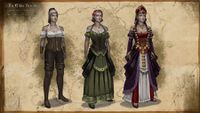
Influenced by constant warfare, Breton fashion is very utilitarian with various flairs,[7] while Breton arts and crafts are influenced by their time under the Direnni.[19] Examples of both together are Breton armor and weapons, which are ornate but practical,[7] yet they also display a sophistication reminiscent of Elven elegance.[19] For clothing, Breton men like to look good in their everyday wear while they're at their trades,[284] while women may add a feminine flair to their clothing.[285] Those seeking to display their wealth do so through rich fabrics and glistening ornamentation.[286] The nobility prefers clothing that is elegant yet austere, which harkens back to High Rock's tradition of knightly orders, which are militant but chivalrous.[287] Nobles typically wear simple yet elegant robes over their clothing when traveling to not sully them, and display their wealth through the metal fastenings holding the robes together.[288] Nobles from Wayrest are known to throw dress-up parties utilizing suits of fur from various animals including even werewolves.[289]
Breton arms are described as standard fare, in that when one thinks of a sword, a Breton blade will typically appear. Despite this, Breton arms and armaments are not unvaried and have can have their own flair, such as that shields may be emblazoned with lion heads, or staves can be carved and adorned with enchanted gems.[290] The mass-produced, one-handed, double-edged heavy broadsword commonly used by the Imperial Legions of the Third Empire were inspired by elaborate, decorated Breton broadsword designs. Broadswords are commonly used with shields, and Bretons favor the heavy tower shield. Highland Bretons were the first to use the heavy two-handed sword called the claymore, but their Redguard neighbors quickly adapted them to their own styles of fighting.[291] Breton bows tend to be longbows—weapons made of one piece of springy wood. Yew, elm, and ash are common in Breton longbows, as the wood is dense and strong, but flexible if tillered properly.[292] The Bretons of old were said to have put skyshard silvers into the hilts of their swords, while early mages are believed to have built staves from roots of the Wyrd Tree.[293]
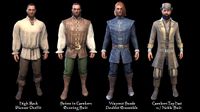
Breton armor consists primarily of leathers, chainmail, scale mail, and plate armor, with tabards and heraldry added to the mix.[UOL 1][294][290] The wealthy are known to add additional materials in the forging process of their plate armor to vary the color of their armor.[290] Bretons see tanning as a fine art. Quality pieces can use soft hides from animals such as guars and cattle strategically placed at areas such as the joints of a gorget, or a wolf's hide for vambraces.[290] Werewolf leather is prized by both armorsmiths and alchemists, and it is known to be utilized especially by Glenumbrans.[289][295] For metals, Bretons are known to use a variety. Common examples are iron and steel, while the more exotic being something along the lines of ebony.[296] Paladins from Daggerfall were able to accomplish creating armor sets surpassing ebony armor in quality[297] with rubedite, a red material. The process starts with enchanted armor that was created with metalworking tools blessed by Akatosh and Zenithar. This armor was then coated with a rubedite metal enamel, and then tempered with captured dragonflame.[298]
Tradition dictates that mages Tamriel-wide wear sturdy and practical robes, the reason being is that magic itself is their armor.[299] Magic as armor is especially true for Breton mages, who are known for utilizing their natural magical talents to stand their ground against the fiercest opponents in battle by summoning fierce daedra to aid them, or augmenting themselves with wards and bound armor.[300] Bretons utilize cloth materials in crafting their style of light-weight armor, which may have structural reinforcements crafted from bone, horn, or cartilage. The outer layer of jerkins and breeches may contain damask or ornamental silk. Underneath that is a layer or layers of durable fabrics such as cambric or burlap, which are often quilted or padded for protection from blows.[301] Breton spellcasters are not limited to using robes in battle. In their society exist spell-knights, which are considered distinct from mages.[15] Breton spell-knights are more comparable to the Tamrielic tradition of battlemages, which are spellcasters that also like to utilize tools meant for melee combat, such as swords and heavy armor.[302] Breton spell-knights are known to equip full plate armor of varying materials in combat, and due to their combat style, their enemies are left with scars from flame and sword.[296][218]
The armor used by the Daggerfall Covenant was influenced primarily by Breton Knightly Orders, such as the helmets and shoulder cops. It also draws from the designs of the Reman Imperials for the cuirass outline, and from Orcish forge-wear for the leg greaves. Regardless, the equipment has the Covenant's imagery overlain on top of it.[303]
Druidic armorers, best described as plant-shapers, use their magic to improve their equipment's defensive and offensive traits. Their work is essentially vegetation carved and coaxed into intricate structures with near iron-like density.[304][305] The wood used remains alive, aware, and unharmed. Druids also use leather for their armor, but with a sense of loss and respect for the animal it was harvested from.[305]
In honor of their patron's sacrifice, its tradition for the Knights of St. Pelin to mix in the blood of a new recruit in the ink used for their tattoos containing sword and wing iconography.[306] The Glenmoril Wyrd are thought to use spriggan sap in their tattoo ink, so that the wearer may form a more intimate bond with nature.[307] Druidic tattoos which can be quite colorful have been made out of mystic ink, and these markings can serve to respect, give in, or to placate nature.[308][309][310][311]
Hair discs have been utilized by Breton nobility.[312] Boarbristle brushes and straight razors are common Breton tools.[313] The "Breton Tonsure" is a hairstyle in which a part of the hair around the scalp is shaved and left bare.[314] "Azure Ombre" is a blue hair style created through an alchemical process by the Breton Dabienne Geontene during the Interregnum, whose dyeing methods were also adopted by people of other races.[315] Female Bretons in the Iliac Bay also utilized blue hair during the late Third Era.[316] Mariner beard oil is used by Gonfalon Bay sailors to keep their facial hair lustrous.[317] Away from the waves, elaborate up-dos are traditional in Breton high society with written visual guides existing for brides seeking to marry into Breton families.[230] Seasalt spray is also used in these elaborate styles.[318] Breton nobles from High Isle use powdered pearls as an ingredient for mouthwash and also whiten the teeth.[319] Bretons employ manicure sets complete with nail clippers and more in fanciful shapes.[320]
Bretons have a variation of preferences for perfumes, colognes, and other scents. Romatic scents of rain and smoke are popular,[321] and their bedchambers may smell of sweet smelling oil known as "Mara's bosom".[322] The musk of black bears is used by Bretons as well and applied behind the wrists and ears[323] and Breton royalty like that of Cumberland have royal alchemists who create colognes just for them.[324] There also exist wealthy Bretons whom enjoy wearing "Orc sweat cologne" to "unleash their inner Orc."[325] Not every Breton fragrance is meant for others of their kind. The sisters of the Glenmoril Wyrd apply an herbal fragrance along their legs, which is meant for the pleasure of their wolves,[326] whom they live alongside and use as guardians.[327]
Domesticated Animals[edit]
Bretons are known for keeping a variety of domesticated animals for various purposes. Livestock such as Cows, Horses, Sheep, Pigs, and pets such as Dogs and Cats, can be found throughout High Rock.[328]
The Shornhelm Shepherd is a dog bred for sheep herding in Rivenspire's rugged terrain. They are known for their strength, speed, and their fierce loyalty, and they can be used as guard dogs.[329] The Great Daenian Hound are gentle giants bred by the Beldama Wyrd for their protection and to serve as companions. They were adopted as trackers by the werewolf-hunting Silver Dawn.[330][331] The Menevian Coachdog is a species known for its white coat marked with dark spots. They are perceptive and serve as deterrents to roadside hazards for the carts and coaches they often accompany.[332] The Breton Terrier was originally bred to kill rats around the Iliac Bay's docks, and it is known for having a joyful disposition.[333] The Glenumbra Border Wolf resembles Breton dog breeds in coloration, and has been bred as a mount to carry couriers though harsh weather and the dark of night.[334]
Wealthy Bretons often let Piebald Cats wander the hidden passages of their manor homes. This comes from a tradition that was created out of necessity due to infestations of Sheogorath's never-there beetles, which the cats eventually purged.[335] The Indigo Senche-Panther is a Senche originally bred to be mounts by a reclusive family in Rivenspire, which is said to hunt werewolves for amusement.[336] The Senche-Serval mounts originating from the Summerset Isles[337] have also seen some use in High Rock and the Systres. The nobles of House Mornard used to be the only to ride on the Ashgray Senche-Serval breed, they became more common among mount-users throughout Tamriel after the noble house fell on hard times.[338] The Knights of the Silver Rose utilized Senche-Servals to rid their fortress of pests and other types of issues.[339]
The Evermore Painter's Moth, local to the eponymous city is a moth whose natural pigments are utilized by artists for their paintings, a notable example being the portrait of Duke Blaise Guimard. Artists have domesticated and have even raised sanctuaries for these insects.[340] The ravens of Rivenspire are some of the smartest of Tamriel, and have served as companions.[341] The blue cockerals of Alcaire are known for their "noble duty" of screeching at daybreak which continues throughout the morning.[342] Two Chub Loon breeds are kept for companionship in the Systres. The Hay-Crown breed are seen as omens of good harvests, and they were originally from Rivenspire where they were rendered extinct, but those that were taken to High Isle survived.[343] The Fellbraun Chub Loon is native to the island of Galen, and are seen as a blessing from Y'ffre.[344]
The Bretons are known to keep a variety of horses. They are integral to the way of life of the Bjoulsae River Tribes, and the power and splendor of Breton mounted knights has been proven in battle.[219] The Daggerfall Dapple Horse comes from the Farwatch region in Glenumbra, and it is favored by long distance riders.[345] The Coalsmoke Forge Horse was bred by Breton blacksmiths with their strength in mind to allow them to work long hours.[346]
In King's Guard region of Glenumbra, a species of ram have been bred as steeds, and the superstitious believe they bring about good luck.[347] Over in the Systres, the Oaken Order tamed green-hued mountain goats as mounts and companions.[348]
Originally a Direnni creation,[349] Quasigriffs are cousins to Gryphons, and those of the Baysong breed are a colorful and flightless creatures adored by and ridden by Breton nobles of the Systres.[350]
Maritime and Mercantile Industry[edit]
Bretons have a thriving and often intrepid merchant class that intersects with maritime activities.[1] "Merchant princes",[351] "warrior-merchants",[7] and "merchant knights"[37] are some societal archetypes, and Bretons that are encountered outside High Rock are often merchants or mercenaries.[8] Indeed, Bretons are often described as shrewd merchants, and as a race they are said to value prosperity over glory.[6] The Improved Emperor's Guide to Tamriel stereotypes Bretons, believing them to be worship money over praying to the divines.[7] Sometimes Breton's merchant-oriented side of society manifests in a darker way via illicit activities. Breton lackeys and merchant lords have been involved in cartels, drugs, piracy, or at times even slavery as some examples.[352] High Rock's Coin-barons participated in the trade of illicit goods such as slaves during the First Era.[UOL 8][132]
Some of the earliest known Breton-made vessels are contained in the oral histories of the druids. It is said that Y'ffre taught the last Druid King how to sing seaworthy vessels into existence, and he in turn taught the druids to do the same. The plants and trees of High Rock are said to had been altered to the exact specifications needed to be used as materials for this endeavor.[55] Similarly, scholars theorize that the trees of the Systres island of High Isle were also influenced by the druids to be well suited for shipbuilding.[353]
By the mid-Second Era, Bretons dominated in the naval shipbuilding industry, which is greatly interlinked with their prime trade routes. In the Systres Archipelago, the Bretons of House Dufort are perhaps the premier shipbuilders of Tamriel. Vessels from Dufort Shipyards can be found in every navy, and their craft is well known and ranked among the finest. Due to "integrated business concerns", their rivals of House Mornard share a mutual reliance on each other, with much of their trade being done on Dufort vessels.[353] House Dufort provides war ships for High Rock, and their merchant vessels House Mornard utilizes to trade at every significant port across Tamriel.[354]
The Bretons of High Rock primarily utilize the waters of the Iliac Bay, the Eltheric Ocean,[203] and the Bjoulsae River for trade. The Bretons have experienced a number of naval battles, much due to their strategic and economic value.[109] High Rock has large enough of a problem with piracy that the Masconian Trade Way was created in an effort to reduce it.[92][7] Much of the small islands of the Bjoulsae River houses sea raiders.[355] Captain Blackheart is a pirate that managed to secure a fearsome reputation among the locals,[356] and his eponymous island gained one just as terrifying.[355]
One type of Breton merchant ship can be described as large wooden vessels rigged with square sails. These ships have also been utilized to carry troops.[7] Warrior-sailors from High Isle often take on posts on escort ships, seeking to hone their martial prowess on the seas.[357] During the Second Era, Breton ship architect Jeromec Lemal sought to revolutionize navel warfare. His designs would include thicker masts, extra backstays, a narrower keel, lighter ballastas, reinforced hulls, and other improvements.[358]
The Bretons of the Systres Archipelago exports many raw materials and trade goods,[359] accomplished through logging, mining, and shipbuilding.[131] Especially important is Eltheric Ammonite which washes up in the archipelago's shore. Collectors covet their beauty, while mages use them as an ethical alternative to soul gems for a raw source of magicka.[359] Larimar is another important trade good, a milky-blue gemstone exclusive to the Systres, making it extremely rare and expensive.[259][131] Though it has become a highly coveted rarity overtime,[131] shipments of Frog-Metal from the Systres isle of Amenos are still exported.[360] Druid-crafted volcanic jewelry has also been found exported outside the Systres.[259]
In High Rock, the biggest source of Orichalcum in history was found near Wayrest circa 2E 561, which improved trade throughout High Rock.[144][361] Feathers belonging to Harpies such as those from the Shrieking Scar in the Daggerfall highlands are valued, for they are used in goods such as quality calligraphy sets and kites.[7][362] Earthenware is a common form of pottery in High Rock, and is used for goods such as chamber pots.[363] Trade is greatly influenced by High Rock's ties to other provinces. For example, during the days of the Daggerfall Covenant, goods of Hammerfell reached a broader market in High Rock, with goods such as tapestries, embroidered throw pillows, and delicious pomegranate wine being desired luxury goods. As a downside, trade became restricted and less frequent with eastern Skyrim which joined the enemy Ebonheart Pact, and some who previously traded with the Nords got put out of business.[364] On the other hand, the Systres is an established neutral ground, and the Bretons of High Isle greatly profited from their neutrality in the conflict.[3]
Recreation: Art, Sports, etc.[edit]
Bretons have a variety of recreational activities. Bardic traditions serve as a unifying legacy for the Bretons,[5] with examples including works such as "The Gonfalon Maid" celebrating love, "Blessings of Y'ffre" for the eponymous god,[365] or "The Battle of Glenumbria Moors" for the historical and pivotal victory.[95] Kieran the Bard is a literary figure that has shrines called Kieran Theatres throughout the Iliac Bay,[366] while the bard and poet Darius Shano serves as a reminder to not deal with daedra.[192] Named the Poet-Champion by Potentate Savirien-Chorak, Nynelle Dumaris rose to prominence with her famous sonnets A Lissome Sprite and Fearless as the Sun,[367][368] after she became the victor of the poet tournament held in the Imperial City in 2E 400.[369]
Bretons utilize a variety of instruments. Lutes and drums are standard,[370] while the talharpa is a variant of a lyre that also sees use,[371] and bugles are known to be used during war campaigns.[372] Bellowing instruments known as concertinas also exist,[373] while Key Harps are the favored instrument in High Isle.[374] Pan flutes used by druids are rumored to have originated from a group of Fauns willingly showing them how to make them.[375] The Stonelore druids are known to wear a bracelet of bells during their ritual dances around fires.[376]
A painting known as the "Frolicking Trolls of Eastmarch" is said to depict how Bretons imagine the frost trolls of Skyrim; the painting depicts frost trolls smiling and dancing in the snow.[377]
Bretons have a multitude of activities to pass the time. There exists a sport called "Bretonball", which is played with rackets.[378] Racing rowboats is a centuries old past time which centers around the Bjoulsae River.[379] Shuttlecocks that were traditionally used as a lure in falconry has been repurposed into a sport involving making it fly with wooden paddles.[380] Triangle Chess involves a three sided board.[381] Khimera is a traditional Breton Yard-Game played by children that is themed around the Chimeras of legend.[40] The denizens of High Isle enjoy "Proof", a murder mystery role-playing card game based on the Investigator Vale book series.[382]
Religion[edit]
The Bretons believe that two opposing forces have existed since before the gods were born. They are referred to as the Light and the Dark by some. They are antithetical to each other, and neither fit the mortal definition of good and evil. They are technically immortal, as they're not living beings, but they exist. The Aedra and Daedra are pale reflections of the eternal conflict between the Light and Dark. Their struggle creates energies that distort their surroundings, and those energies are so powerful that life can appear. The Light and the Dark are evenly matched, and will never resolve their conflict.[383]
The undead and the Daedra tend to align with the Dark, as their natures are more akin to it. Mortals and the creatures of Mundus are more aligned with the Light. The evils of mortalkind are not always attuned to the Dark, but those that do are incredibly dangerous. Magic is believed to come directly from the energies swirling about both entities: the energies are impersonal intermingled. Black magic is more a matter of intent than effect. Destruction spells on their own are not black magic, but destruction spells hurled at innocent people are. The destruction of Daedra strengthens the light just a little, and the destruction of a Tamrielic creature strengthens the Dark in much the same way. The gods are believed to mostly align with the Light, save for a few who are more ambiguous. Mortals and those that reside in Aetherius can perceive traces of the Light and Dark; the Light inspires most mortals to behavior deemed good by human standards. What the denizens of Mundus can perceive of the Dark is utterly evil by human standards; those who have visions of the Dark are often driven mad. The Dark is described as an emptiness that draws the soul in to be twisted and destroyed.[383]
Some sources indicate that Bretons are not disposed to "excessive religion",[56] though others contradict this claim and place them nearly as devout as Colovian Imperials.[7]
Religious History[edit]
The earliest Bretons, the Manmer, worshipped a variety of gods derived from the faiths of their Nedic and Aldmer ancestors. Some known gods include Sheor[384] and Hircine.[13] These Manmer inherited a form of nature worship from their Nedic ancestors, but this faith split into two separate subcultures. The witches of the Wyrd became their own entity due to the elves, and these witches continue to worship "old gods of the ancient past" in the modern day.[13] Druidism on the other hand arose as a distinct identity shortly after the Bretons first came about,[18][15] and their Y'ffre-centric religion survived in the Systres Archipelago after their exodus.[2] Druidism would later be reintroduced to mainland Tamriel, specifically around the Iliac Bay.[165][UOL 13]
The details of the influence of Aldmeri religion among the earliest of Bretons is sparse. Evidence of peaceful cultural diffusion of religion between men and mer exists in the form of unearthed ancient idols of Mara as depicted in the elven pantheon.[70] Interestingly, Sheor is depicted positively in a lovers embrace with this elven Mara figure,[70] when Sheor is demonized in modern Breton religion[34] and his Aldmeri pantheon equivalent of Lorkhan.[385] Worship of the elven gods still exists in modern Breton culture, such as among Bretons that emphasize their elvish blood, who are often drawn towards Phynaster.[34] The gods Magnus and Y'ffre are traditionally associated with elven pantheons.[98] Though Breton's Nedic ancestors knew of Y'ffre's presence in their hearts and channeled his power,[13] his name was not known to them until the "daughters and sons of … Anuiel" introduced them to the name Y'ffre.[13]
Most Bretons transitioned to the Eight Divines under the First Empire. The Eight Divines are worshipped widely in mainstream Breton culture,[7] but other traditional deities still persist nonetheless. Sheor, Phynaster, Y'ffre and Magnus have significant cults in High Rock.[98]
Major Gods[edit]
Akatosh
The Dragon God of Time is acknowledged as the first of the gods to emerge from the Beginning Place. He embodies endurance, invincibility, and everlasting legitimacy.[98] Akatosh is hailed by the Akatosh Chantry in the Iliac Bay, and the Order of the Hour is his sword.[386][387] He is the patron deity of Wayrest and the Isle of Balfiera.[388]
Arkay
Arkay (also spelled Ark'ay)[389] is the god of burials and funeral rites, and is associated with the seasons.[98] According to a Breton story, Arkay was originally a mortal who ascended to godhood. As the God of the Cycle of Birth and Death,[76] he is charged with keeping the balance of death and life in the universe.[389] In the Iliac Bay, the Order of Arkay celebrates the Blessed Neutrality that Arkay stands for. They do not offer blessings, for to give favor or disfavor upon one would upset the eternal balance. Their libraries and sages are some of the finest in Tamriel.[390] The Knights of the Circle are the military arm of the Order.[391] Arkay is the patron deity of the Ilessan Hills and Shalgora.[392] Arkay is also the patron of House Tamrith, who are devout followers of the Light.[393][394] The scions of House Tamrith study the Way of the Light and obey Arkay's teachings.[395] Their holy symbols bear the crest of House Tamrith and the symbol of the Light of Arkay.[396] Arkay's holy relics can be used to combat the undead.[397]
Dibella
The Goddess of Beauty is very popular. She has many different cults dedicated to different aspects of her worship: some are dedicated to women, some to aesthetics and art, and others to erotic instruction.[98] In the late Third Era, similarly to Hammerfell, the House of Dibella was responsible for the administration of temples dedicated to Dibella in the province of High Rock, and its militant branch, the Order of the Lily was also active in the province at this time.[398] Dibella is the patron deity of the regions of Koegria and Menevia,[399] and is venerated as a member of the Breton pantheon.[98]
Jephre
Jephre (also known as Jeh Free)[400] is the God of the Forest and the spirit of the "now". Jephre is typically considered an elven god, and is understood to have turned himself into the Earth Bones and establishing the laws of nature.[98] He is still revered by some Breton hunters and farmers.[7] The Beldama Wyrd also worship him.[401] Bretons respect the Vicars of Jephre, a group of his adherents who are known defenders of the natural world.[402] The druids recognize Jephre as Y'ffre, the Green-King, the Slumbering Father of Nirn, and is their a primary deity.[18]
Julianos
The God of Wisdom and Logic is a favorite of Breton mages. He is the god of history, literature, law and contradiction.[98] In the Iliac Bay, temples dedicated to him are known as Schools of Julianos.[403] As their name implies, these temples are considered educational institutions.[404] They are believed to have spread the term "magicka" to describe the "power associated with performing magic".[405] The templar knightly order associated with the School of Julianos is the Knights Mentor.[406] Julianos is the patron deity of the regions of Daenia, Dwynnen and Tulune.[407]
Kynareth
The Goddess of Air is a patron to sailors and travelers. Legend holds she was the first to agree to Lorkhan's idea to invent the mortal plane, and she provided a space for its creation. Kynareth is associated with rain.[98] The island of Betony is considered holy land of Kynareth. This was a factor for Daggerfall's involvement in the War of Betony. It was also the reason why the conflict escalated to the Battle of Cryngaine Field which ended the war.[408] The Temple of Kynareth does her work in the Iliac Bay. In the Third Era, her Temple contained the greatest physicians in Tamriel; their ability to cure magical and mundane diseases was said to be unrivaled.[409] The Kynaran Order is the militant arm of the Temple.[410] Kynareth is the patron deity of Alcaire, Daggerfall and the Wrothgarian Mountains.[411] The air spirits Amaro, Pina, and Tallatha, are acknowledged as the fingers of Kynareth by the Skeffington Coven.[412]
Magnus
Magnus is the god of sorcery, who withdrew from creation at the last second. He is represented by a golden eye, an astrolabe or a telescope, but a staff is his most common symbol. Legend holds that he can possess powerful wizards and lend them power.[98] Breton followers of Magnus sometimes use wicker effigies as stand-ins for themselves when performing certain rituals.[413]
One known Breton sect that worshipped Magnus is the Priory of the Golden Staff, the Priory believed in Magnus's grand design for the Mundus, and his disappointment at the flaws introduced into his creation. They also believed that some of the Magna Ge once sought a tool to unmake what had been made wrong, in order that it could be remade in accordance with the Architect's plan.[414]
Mara
Mara is the Mother-Goddess, and is married to Akatosh in Breton lore.[98] She is the patron deity of several regions of High Rock, such as Anticlere, Betony, Glenumbra Moors, and Northmoor.[415] In Anticlere, the 21st of Last Seed is known as Appreciation Day, an ancient holiday of thanksgiving for a bountiful harvest. It is considered a holy and contemplative day devoted to Mara, the goddess-protector of the region.[416] Temples dedicated to the Divine are administered by the Benevolence of Mara, a religious organization dedicated to Mara and her teachings, and can be found in major urban centers throughout the province.[417] The Maran Knights are a controversial knightly order dedicated to Mara and the protection of her temples.[418]
Phynaster
Phynaster is an Altmer hero-god who is the patron deity and teacher of the Direnni. He is often worshipped by Breton mages who care about their elven blood.[98]
Sheor
Also known as the Bad Man, Sheor is the source of all strife. He originated as a god of crop failure, and is believed to have been introduced by the elves during their conflicts with the Nords as a demonized version of Shor.[98] Some sculptings created by the Bretons' Nedic ancestors have been found in Glenumbra, which portray what appears to be their version of Sheor before he was villianized, paired with Mara as an Aldmer.[70]
Stendarr
Stendarr (also known as Shandar) is known as the God of Mercy, and is the patron of magistrates, rulers, and knights errant. He is a god of compassion and righteous rule.[98] Temples dedicated to the Divine can be found throughout the Iliac Bay and are administered by the Temple of Stendarr, a religious organization dedicated to Stendarr and his teachings, which offered healing and training to the population of the Iliac Bay. Some mock their compassion, calling them sentimental fools and tenderhearts; but everyone comes crawling to Stendarr when Sai, the God of Luck, abandons them.[419] The Crusaders, also known as the Knights of Stendarr, are a knightly order dedicated to Stendarr which protect his temples against its adversaries, such as the Citadel of Ebonarm.[420] Stendarr is the patron deity of Bhoriane, Phrygias and Urvaius.[421]
Zenithar
Zenithar (often shortened to Z'en) is the God of Work and Commerce is a cultivated god of merchants, artisans, and middle nobility. His faithful tout him as a god "that will always win".[98] He teaches Bretonkind that they will be rewarded if they work hard. He also teaches them to be wise in their spending, and to never steal from others. Many of his rewards are those of the spirit: being productive, whether farming, smithing, or creating, honors Zenithar. Zenithar wishes for his faithful to find joy in their work.[422] In the Iliac Bay, the Resolution of Zenithar pays heed to the god.[423] Zenithar is not merely the God of Merchants and Commerce; he is also a warrior god. The militant arm of the Resolution, the Knights of Iron, represent this part of him.[424] Zenithar is the patron deity of Gavaudon, Kambria and Glenpoint.[425]
Minor Gods[edit]
Baan Dar
Baan Dar (also known as "the Bandit")[400] is noted to be a considerable force within the lands of High Rock by Arkan the Wise, a Second Era scribe to Daggerfall. The First Scroll of Baan Dar he transcribed goes further, by stating he manifests across Tamriel to aid people in times of need.[426] Indeed, this aspect to his character is explored in the historical-fiction novel, King Edward, when Queen Aliera praises him along with other gods for bringing her husband Moraelyn and son Edward to her safely.[400] He is known to be revered by the Thieves Guild branch in the Iliac Bay.[427]
Druagaa
The Old Goddess of Flowers. A festival named Gardtide is still held in her honor on the 1st of Rain's Hand every year by the people of Tamarilyn Point, a coastal region of Menevia in central High Rock.
Ephen
Ephen (also known as S'ephen)[405] is the center of a temple-cult who worships him as The God of the Wild[UOL 18]. He was a Chimer noble that was active during the early-First Era. In death, he was given the duty of safeguarding the Horn of Summoning and eventually the Staff of Chaos. Statues of Ephen depict him wielding a hammer, atop of an anvil of adamantium,[84] and shrines dedicated to him can be found across the Iliac Bay.[366]
Jhim Sei
The nature of Jhim Sei is unknown, although their sphere of influence may revolve around music, since they are compared to Jephre, the elven God of Song and Forest in the historical-fiction novel, King Edward.[400] There are shrines dedicated to Jhim Sei across High Rock.[366]
Mara's Tear and Shandar's Sorrow/Stendarr's Sorrow
Mara's Tear and Shandar's Sorrow are the ancient Bretonic interpretations of the moons and were originally mortal lovers in a forbidden relationship. After Shandar suffered a mortal wound defending his lover, the goddess Mara took the two mortals and placed them in the heavens so they could always be together, and the light of their love could shine upon the world as moonlight.[428] Ancient druids had Mara's Tear and Shandar's Sorrow as a witness to sanctify rituals.[58][429]
Notorgo
Notorgo is known as the Messenger God.[UOL 18] He is mentioned in the King Edward series of books, where Queen Aliera praises Notorgo along with other gods for bringing her husband Moraelyn and son Edward to her safely.[400]
Q'Olwen
Little is known about this deity, except that it is associated with those in pursuit of lore.[UOL 18] Q'Olwen is worshipped in the Iliac Bay area, where shrines to him can be found.[366]
Raen
Raen is the Breton God of Agriculture.[UOL 18] Reliquaries of Raen can be found across the Iliac Bay region.[366]
Reymon Ebonarm
Reymon Ebonarm is the God of War, a deity of some significance to the Bretons.[430] He is featured in the Bretonic historical novel King Edward. He has shrines in the Alcaire, Daenia, Daggerfall, Dwynnen, Ilessan Hills, Kambria, Wayrest, and the Wrothgarian Mountain regions of High Rock.[366]
Sai
Sai is the God of Luck. He was born a mortal and had the talent to spread luck to others, but not to himself. He became a soldier, but he was killed in his first battle just as it was won. Ebonarm appeared to him, and offered him immortality if he agreed to spread his luck around. He said the gods were overworked seeing to events, and thought that Sai's inborn talent would balance things out. He readily agreed, and he was told that he could keep his body for a time before it began to fade.[431] Excessive worship of Sai causes the disease known as Sai's Affliction. Sufferers of the disease have been abandoned by Sai, and long for the god's presence. They are driven to incessant gambling, seeking proof of the god's favor. This usually leaves the victim in poverty or debt.[431] Followers of Sai sometimes convert to worshipping Stendarr when Sai abandons them due to Sai's Affliction.[432] Reliquaries dedicated to Sai can be found throughout the Iliac Bay region.[366]
Sethiete
Sethiete (also called Seth)[433] is a deity that is worshipped across Tamriel. The nature of Sethiete is unknown, but what is known is his influence. His places of worship are known as the Temples of Sethiete, and one of his temples is a landmark in the city of Camlorn that anchors the main street with the Royal Palace.[434]
Vigryl
Vigryl (also called Vir Gil)[400] is the God of the Sea[UOL 18] who is worshipped in the Iliac Bay area.[366] People pray to Vigryl to bring them better weather conditions.[UOL 18]
Saints[edit]
The Bretons have saints that are affiliated with a god, and have usually performed great deeds.
Ellenica
Saint Ellenica was a priestess of Arkay.[397] Her prayer book is a holy relic, and contains passages that can be read to put the dead to rest.[435] She was buried in Flyleaf Catacombs with her prayer book, which was retrieved in 2E 582.[436]
Marben
Saint Marben is a saint of Arkay.[397][437] Saint Marben's Fingerbone is a holy relic of Arkay, and was buried at Sanguine Barrows until it was retrieved from Saint Marben's grave in 2E 582.[438][439]
Octavien
Saint Octavien was a Priest of Arkay who was slain with a scythe by Daedra worshippers.[440] The broken scythe blade that killed Octavien is a holy relic of Arkay. It was buried in a tomb near Lorkrata Hills until it was retrieved by a Knight of Arkay in 2E 582.[441]
Pelin
Saint Pelin the Martyr was a Breton priest of Stendarr that ascended to the role of sainthood following his divine act in the defense of the Bangkorai Garrison in 1E 1029, which in turn, brought the province of High Rock into the First Empire of Cyrodiil. He had become a folk hero to the Bretons of Evermore and the greater region of Bretonic-Bangkorai, memorialized by the chapel of St. Pelin in Evermore, the Order of Saint Pelin, the knightly order of the Kingdom of Evermore, and the great cemetery called Pelin Graveyard.
Stental
Saint Stental slew the demon of Overlook Hill (also called "the Leaper"), rescuing the three Sisters of Kynareth from an untimely death.[442] A statue dedicated to him was built where the demon was slain.[443]
Vitache
Saint Vitache is the Patron of Millers, Scissor-Grinders, and Bathhouse Attendants. She was honored daily by the millers of Northglen in 2E 582.[444]
Revered Persons[edit]
Druid King
The Druid King (or Druid Queen and Archdruid) is more accurately described as a title rather than a person. It is a position for the highest authority among the druids, and a philosophical figure that is revered in High Rock. The role of Druid King is not inherited, as titles among the druids are earned.
The Druid King has the authority to bind and command the nature spirits safely, entities that are as unpredictable as nature itself. The Druid King has dominion over nature in that they can bring prosperity or make nature run amok.
Eleidon
Eleidon was a renowned holy Breton knight of legend. He was recorded in Breton history as a highly esteemed individual, admired for his bravery and unwavering commitment to set all wrongs right and fight against any injustices. Many stories exist about Eleidon's gallant and brave deeds, including a particularly well-known tale in which he saved a baron's daughter from certain death at the hands of a warlord. In recognition of his noble acts, the baron expressed his gratitude by commissioning the creation of an enchanted shield, known as Eleidon's Ward. This artifact was imbued with magical properties, allowing the wielder to heal wounds.
Gyron Vardengroet (The Sage)
Gyron Vardengroet is an immortal wizard of legend that was born in the early years of the Second Era, and was prophesied by the Gods as a champion that would be sent down to guide others and bring wisdom. His exploits would earn him the title of The Sage, and Great Sage. Physically, he is described as a tall, bald, and bearded Breton with dark eyes, an indigo robe trimmed with gold, a pointed wizard's hat, and an intricately carved staff. He is the primary figure in the books The Sage, Feyfolken, and The Final Lesson. Gyron has monuments erected in his reverence in both High Rock and Hammerfell. He was listed alongside Voernet and Druid King Kasorayn as one of the most powerful Breton mages in history. According to Divayth Fyr, "Gyron Vardengroet" was not his real name.
I'ric Harad Egun
I'ric Harad Egun (sometimes shortened to I'ric) was the Altmer archmagister of the Crystal Tower, believed to be alive sometime in the early-mid First Era. His name is widely known and is comparable to the likes of Moraelyn, the Witch-King of Ebonheart, and Ebonarm, the God of War. According to the historical fiction, King Edward, his name is implied to have significant weight, and so throughout the story, he is simply referred as the ArchMagister. He is worshipped at altars in High Rock and Hammerfell.
Kieran
Kieran the Bard is a figure that is shrouded in mystery. Some of his stories have been lost, while others were successfully documented. His recorded tales fall into three categories dubbed the Woodland Cycle, Castles and Kings, and an unnamed lustful category. Some stories have become mere shells of the original and are now simple bedtime stories, and it is unknown if his stories are based on true events, allegory, or if they were simply written to entertain. He has shrines called Kieran Theatres in Hammerfell and High Rock, and he is of significance to Bretons. A Bretonic ruler of a kingdom neighboring the Bloodfall Kingdom is rumored to have had a tale of Kieran staged for the Old Life Festival.
The Viridian Sentinel
The Viridian Sentinel protects the human inhabitants of northern Bangkorai from the beasts and witches that live in the forest. According to the legend of the Viridian Sentinel, long ago the Direnni forged a covenant with the Earth Bones to protect their settlements located throughout all of High Rock from the wild. The Bretons, who displaced the Direnni, had no such arrangement, and as a result their farms in Bangkorai were gradually overrun by the wilderness. The people were pushed to the brink of starvation, causing a young boy called Greenward to pray to Stendarr for salvation. Stendarr taught him to forge a new pact with the forest, giving him the power to restrain the natural creatures within. He thus became the first Viridian Sentinel.
The Viridian Sentinel has great power over the forest, and can use this power to perform potent feats of magic. When the Glenmoril Wyrd became bound to the forest, they also gave some deference to the Sentinel due to that connection (though they had not been a party to the original pact). Although Viridian Sentinels were known for their longevity, over time, the Sentinel ages like other mortals, and must pass on their power and title to a new mortal before death. Their eyes age at a normal rate, however, and therefore a Sentinel usually requires a monocle when reading to counteract deteriorating eyesight.
Artifacts[edit]
Chrysamere[edit]
Chrysamere (also called the Chrysamere Blade, or the Chrysamere) is an ancient adamantium claymore artifact with offensive capabilities only surpassed by its defenses. It has magical properties which, unlike most weapons, are defensive in nature: it heals the wielder, grants them resistance to fire, and reflects hostile spells. It is unaligned, and is not a Daedric artifact. Chrysamere was forged in the late Merethic Era by the Breton swordsmith Asterie Bedel, who delighted in using the techniques of both man and mer in her creations. In Chrysamere's case, this most clearly manifests in the placement of her maker's mark, a "mage's knot" within the heart of the sword that is said to harken back to the earliest days of Bretonic culture. Chrysamere is also said to have been influenced by the magic of Breton society's Elven forebears, and it gained further enchantments over time. Chrysamere does not typically stay with one swordsman for long, for it chooses not to favor one champion. It has earned the title of the Sword of Heroes, but it also goes by other names such as the Sword of Kings and the Blade of Blades. Chrysamere is considered a holy weapon, and in this context it is referred to as the Sword of the Paladin, or simply the Paladin's Blade.
Druid King's Regalia[edit]
The Druid King's Regalia consists of a crown, a gauntlet, and a staff which were created by the god Y'ffre. These gifts were worn with wisdom and mercy by the line of Druid Kings,[429] and serve to legitimize one's ascension to the Ivy Throne.[166] After the death of Kasorayn, the last Druid King, they remained dormant within sacred seeds entrusted to the three main Druidic Circles.[58] The regalia supposedly has no innate power of their own,[63] but after a pretender stole the Druid King's Regalia, they almost brought upon the Green Scourge which would have called forth the wrath of nature upon Tamriel but they were slain before being able to do so.[158]
Eleidon's Ward[edit]
Eleidon's Ward is an enchanted shield especially built for Saint Eleidon, a renowned holy Breton[445]:241 knight of legend. One of the many stories about him is that he saved a baron's daughter from sure death at the hands of a warlord, and the baron spent all his riches on the creation of the shield to show his gratitude. Eleidon's eponymous shield grants the wielder the opportunity to heal their injuries.[38]
Lady Garick's Sacred Shield[edit]
Lady Joslin Garick was a premier captain for the All Flags Navy. Aside from her exploits, she was known for what she referred to as her "Sacred Shield". This eponymous ward she claimed was blessed by a saint of Arkay, though long after her passing, legends would paint it as Arkay himself that endowed his power into it. The shield was said to preserve the wielder's life, in that no injury would befall them. The legends seemed to have some merit, for her crew would always return safely. However, the one instance she left her shield behind for safe keeping was her last voyage, as she and her crew met their demise during the All Flags Navy's assault on Thras.[120][446]
Ring of the Pale Order[edit]
The Ring of the Pale Order was a signet ring belonging to a prominent member of the Bretonic Knights of the Pale Order, who were known for their persecution of the Direnni when they fled to Balfiera around the end of the Fifth Century of the First Era. The ring is said to give off a cold surge of power and a deep nagging paranoia, and it invigorates the wielder as they inflict damage to their wielder. The enchantment however becomes less potent the more people that accompany the wearer. Thus, members of this knightly order were known for keeping their own company, and rumors abound of them and their associates being vampires or resorting to dark magics. It was not uncommon to see members of the Pale Order covered in blood yet growing stronger as battles went on.[447][448]
Shade Sickle[edit]
The Shade Sickle is a Breton-made weapon with the ability to separate the living from their shadows. This leaves its victims fated to gradually become hapless beings akin to thralls. Though mortal in origin, it is now a daedric artifact associated with the Daedric Prince Nocturnal, who was given the weapon at one point after its potential was realized. Nocturnal considers it a powerful instrument of her will. Despite its common appearance, the blade is preternaturally sharp, and those who gaze at it experience a deep sense of foreboding.
Gallery[edit]
Appearances[edit]
Miscellaneous[edit]
Notes[edit]
- Bretons traditionally fulfill the role of being the medieval race of The Elder Scrolls universe.[UOL 19]
- Bretons pull from many influences, such as from the real-world Bretons,[citation needed] the Celtic,[UOL 20] and the French.[UOL 21]
- Breton society is described as Thronesian,[UOL 3] but the influence of Arthurian legends also has a place in it.[UOL 1]
- The largest real-world influence on the feudal Bretons of High Isle on the Systres Archipelago was the ancient Roman city of Baiae, known for its hedonistic practices and having local volcanic activity.[UOL 20] To differentiate them from other Bretons, Systreans draw from the Germanic medieval period for their castles, armor, and motifs.[UOL 19]
- The architecture of the Druid subculture takes inspiration from the Moai, Olmecs, and the Stonehenge. Influences of their Rock-cut architecture came from ancient Turkey, such as the Lycian tombs in Dalyan and Göreme Historical National Park.[283]
- In A History of Daggerfall, the Direnni were originally described as native Bretons. Although they are described to be predominantly Altmer in later content, they still have some humans in their ranks.
- House Telvanni often prefers to hire Bosmer and Bretons as mercenaries to ensure they are left in peace.[453]
- Bretons have a higher tolerance to alcohol but take longer to recover.[454]
- Artist Dennis Mejillones, who created the NPC model art for Skyrim, mentioned this in regards to the aesthetic of Bretons: "I put all my [facial] features in the game, so I can make myself in the game, so I actually drew my eyebrows that's one of your options, and the facial hair -- all that stuff. So I even had screen capture somewhere of myself [as] my character the game, it was the Bretons." Jonah Lobe asks, "So basically the Bretons are Cubans?" to which Dennis responded, "Basically yeah, in my mind [laughs]!"[UOL 22]
- Julian Lefay, the game director of Daggerfall, has a thick Danish accent, and narrates the introduction and endings of Daggerfall himself. He also voices the Ghost of King Lysandus, which would mean the Bretons, at least those of Daggerfall possessed the real world Danish accent of Lefay. However, this was obviously not carried forward for later games.[455]
See Also[edit]
- For a list of notable Bretons, see here.
- For game-specific information, see the Arena, Daggerfall, Battlespire, Morrowind, Shadowkey, Oblivion, Skyrim, Elder Scrolls Online, Legends, Blades, and Castles articles. Also see the Redguard category.
Books[edit]
- A History of Daggerfall by Odiva Gallwood — A relatively unbiased analysis of Daggerfall and the Iliac Bay
- Ark'ay The God by Mymophonus the Scribe — How Ark'ay was transformed from a shopkeeper into the God of Birth and Death
- Bangkorai, Shield of High Rock by King Eamond — King Eamond's address to his troops at Bangkorai Garrison
- Banker's Bet by Porbert Lyttumly — A humorous story of what people will do for money
- Crafting Motif 5: Breton Style by Doctor Alfidia Lupus — Notes on materials and motifs used in Breton armor
- Etiquette With Rulers by Erystera Ligen — The etiquette of speaking with nobles
- Fahamal, Trader by Fahamal — A Redguard's thoughts on the Breton use of magic
- Holidays of the Iliac Bay by Theth-i — An overview of Breton and Redguard holidays commonly celebrated in the Iliac Bay region
- Legacy of the Bretons A series of musings by Stefan Mornard — A look at the cultural dual-nature of the Breton people
- Mara's Tear by Zhen — An origin myth for the two moons, Mara's Tear and Shandar's Sorrow
- Modern Day Bretons: Man or Mer? by Vastyr Historian Filibert Beauchamp — A historian's treatise on why Bretons are more Mer than Man
- Pocket Guide to the Empire, 1st Edition: High Rock — Imperial Geographical Society, 2E 864
- Pocket Guide to the Empire, 3rd Edition: The Sons and Daughter of the Direnni West: High Rock — Imperial Geographical Society, 3E 432
- Systres History by Trilam Heladren, Associate Dean of Eltheric History, University of Gwylim — A history of the Systres archipelago
- The Bretons: Mongrels or Paragons? by Phrastus of Elinhir — An essay surrounding the ancestral roots of the Bretons
- The Light and the Dark by Irek Unterge — A Breton man describes the Light and the Dark to his two grandchildren
- The Viridian Sentinel — A children's story surrounding the legend of the Viridian Sentinel
- Uncommon Taste by The Gourmet — A cook book containing recipes of a Breton origin
- Wayrest, Jewel of the Bay by Sathyr Longleat — A history of the city Wayrest, circa 3E 405
- Wyrd and Druid Transcribed from Archdruid Barnabe's Discourse with Mainlanders, 2E 553 — The druidic origins of the Bretons, as told by a Stonelore archdruid
References[edit]
- ^ a b c d e f g h i j k l m n o The Bretons: Mongrels or Paragons? — Phrastus of Elinhir
- ^ a b Systres History — Trilam Heladren, Associate Dean of Eltheric History, University of Gwylim
- ^ a b c d e f g High Isle Preview—The Zone from the official ESO website
- ^ a b c d e f g h i j k l m n o p q r s t u v w Pocket Guide to the Empire, 1st Edition: High Rock — Imperial Geographical Society, 2E 864
- ^ a b c d e f Provinces of Tamriel
- ^ a b c d e Daggerfall Covenant game guide on the official ESO website
- ^ a b c d e f g h i j k l m n o p q r s t u v The Improved Emperor's Guide to Tamriel: High Rock — Flaccus Terentius, 2E 581
- ^ a b c Skyrim - The Adventure Game Race descriptions
- ^ a b Anton Virane's dialogue in Skyrim
- ^ a b c Pocket Guide to the Empire, 3rd Edition: All the Eras of Man, A Comprehensive History of our History — Imperial Geographical Society, 3E 432
- ^ a b c d e f g h i j k l Modern Day Bretons: Man or Mer? — Vastyr Historian Filibert Beauchamp
- ^ a b c d e f g Loremaster's Archive - Tamriel's Dungeons — Dhulef
- ^ a b c d e f g h Loremaster's Archive - The Druid Circles of Galen — Laurel of the Stonelore
- ^ a b Breton Race Description in Arena
- ^ a b c d e f g Legacy of the Bretons — Stefan Mornard
- ^ a b c Introduction to the Lore of The Elder Scrolls Online
- ^ a b c d Draoife Storystone codex entries in ESO: High Isle
- ^ a b c d e f g h i j k l m n o p Wyrd and Druid — Archdruid Barnabe's Discourse with Mainlanders, 2E 553
- ^ a b c d Crafting Motif 5: Breton Style — Doctor Alfidia Lupus
- ^ Breton Race Description in Shadowkey
- ^ a b c Breton dialogue topic in Morrowind
- ^ The Sage — Aegrothius Goth
- ^ a b c Holidays of the Iliac Bay — Theth-i
- ^ a b King Edward, Part IX — Anonymous
- ^ Interview with a Dark Elf
- ^ The Real Barenziah, v 2 — Anonymous
- ^ a b c Loremaster's Archive - House Telvanni — Divayth Fyr
- ^ High Elf racial abilities in Morrowind and Oblivion
- ^ Shifty Tom's dialogue in ESO
- ^ Captain Blackheart's Log — Captain Blackheart
- ^ a b c d Meet the Character - Sir Stefan Mornard — Knight Commander Jourvel
- ^ a b c d e f Sir Stefan Mornard's dialogue in ESO: Firesong
- ^ a b Count Damard Dufort's dialogue in ESO: High Isle
- ^ a b c Varieties of Faith: The Bretons — Brother Mikhael Karkuxor of the Imperial College
- ^ a b c Alana Relin and Commander Parmion's dialogue during A Step Back in Time in ESO
- ^ a b Knight of the Direnni passive during A Step Back in Time and The Nameless Soldier quests in ESO
- ^ a b c d e f g The Knightly Orders of High Rock — Lady Cinnabar of Taneth
- ^ a b c Tamrielic Lore — Yagrum Bagarn
- ^ a b Dame Helenie's Quest — Sir Randyl of the Order of the Albatross
- ^ a b The Beast of Galen — Phrastus of Elinhir
- ^ Crimes of the Daggerfall Covenant — Aicantar of Shimmerene, Sapiarch of Indoctrination
- ^ a b Breton Race Description in Daggerfall
- ^ The Art of Skyrim
- ^ The Infernal City — Greg Keyes
- ^ Illustration of a typical Breton male
- ^ Pointed Ears for Bretons during Character Creation in ESO
- ^ a b The Viridian Sentinel
- ^ a b c d Systres History: Volume 4 — Trilam Heladren, Associate Dean of Eltheric History, University of Gwylim
- ^ a b c d e f g h i j k l m n Pocket Guide to the Empire, 3rd Edition: The Sons and Daughter of the Direnni West: High Rock — Imperial Geographical Society, 3E 432
- ^ Daggerfall User's Guide
- ^ Barrowton's Journal — Barrowton
- ^ a b Breagha-Fin's loading screen in ESO
- ^ a b c Frontier, Conquest — University of Gwylim Press, 3E 344
- ^ Druid Audrine's dialogue in ESO: High Isle
- ^ a b c d e Exodus of the Druids — Druid Laurel of the Stonelore Circle
- ^ a b c d e f g h A History of Daggerfall — Odiva Gallwood
- ^ Nedic Hex Totem codex entries in ESO: Greymoor
- ^ a b c d e f g Druid King Kasorayn's dialogue in ESO: Firesong
- ^ Before the Ages of Man — Aicantar of Shimerene
- ^ a b Once — Beredalmo the Signifier
- ^ Bailiff Erator's dialogue in ESO: Summerset
- ^ Druid Farel's dialogue in ESO: High Isle
- ^ a b c d e f g h i Druid Ryvana's dialogue in ESO: High Isle
- ^ a b c d e f g h Loremaster's Archive - Bretons & High Isle — Lady Arabelle
- ^ Wyress Demara and Wyress Linnae's dialogue in ESO
- ^ a b Wyress Matilde's dialogue during Sojourn of the Druid King in ESO: Firesong
- ^ Druid Peeska's dialogue in ESO: High Isle
- ^ a b c d e f g Systres History: Volume 1 — Trilam Heladren, Associate Dean of Eltheric History, University of Gwylim
- ^ High King Emeric's dialogue in ESO: Firesong
- ^ a b c d Manmer Coupled Idol codex entries in ESO: Greymoor
- ^ a b Loremaster's Archive - Infinite Archive — Master Malkhest
- ^ a b Fragment: On Artaeum — Taurce il-Anselma, 3E 400
- ^ Lost Legends — Talsgar the Elder, Archivist of Winterhold
- ^ Daynas Valen's Notes — Daynas Valen
- ^ The Legendary Sancre Tor — Matera Chapel
- ^ a b c d e f g The Daggerfall Chronicles — Ronald Wartow
- ^ Secrets of Amenos — Miramel Charascel, Chairperson of the Gonfalon Bay Historical and Social Society
- ^ Druidic Knotwork Body Tattoos body markings description in ESO
- ^ Crafting Motif 93: Ancestral Breton Style — Serge Serlyn, "Military Scholar of Much Renown"
- ^ a b Systres History Addendum: The Druids of Galen — Varona Vedralu, Senior Lecturer, University of Gwylim
- ^ The Annotated Dream of Kasorayn — Zamshiq af-Halazh, Associate Folklorist at the University of Gwylim
- ^ Stonelore Circle Effigy in ESO
- ^ a b Pocket Guide to the Empire, 1st Edition: Skyrim — Imperial Geographical Society, 2E 864
- ^ a b The Real Barenziah, v 4 — Anonymous
- ^ a b King Edward, Part X — Anonymous
- ^ Rislav The Righteous — Sinjin
- ^ a b c d A Life of Strife and Struggle — King Laloriaran Dynar
- ^ Tower of Adamant — Hrerm House-builder, Bards College, Solitude
- ^ a b Rislav The Righteous — Sinjin
- ^ a b c d Pocket Guide to the Empire, 3rd Edition: Orsinium — Imperial Geographical Society, 3E 432
- ^ a b c d e f g Bangkorai, Shield of High Rock — King Eamond
- ^ a b c d e f g h i j Wayrest, Jewel of the Bay — Sathyr Longleat
- ^ The Last King of the Ayleids — Herminia Cinna
- ^ Day of Release information in Daggerfall
- ^ a b The Battle of Glenumbria Moors
- ^ a b The Horse-Folk of Silverhoof — Doctor Nabeth al-Gilane, Khefrem Academy of Yokudan Heritage
- ^ a b c Ring of the Pale Order codex entries in ESO: Markarth
- ^ a b c d e f g h i j k l m n o p Varieties of Faith... — Brother Mikhael Karkuxor of the Imperial College
- ^ Logbook of Druid Anwas — Druid Anwas
- ^ a b c d Pocket Guide to the Empire, 3rd Edition: The Ra Gada: Hammerfell — Imperial Geographical Society, 3E 432
- ^ King Edward, Part IV — Anonymous
- ^ a b Systres History: Volume 2 — Trilam Heladren, Associate Dean of Eltheric History, University of Gwylim
- ^ Redguards, History and Heroes — Destri Melarg
- ^ a b Pocket Guide to the Empire, 3rd Edition: Other Lands — Imperial Geographical Society, 3E 432
- ^ a b Sentinel, the Jewel of Alik'r — The Unveiled Azadiyeh, Songbird of Satakalaam
- ^ Yokudan King's dialogue in ESO
- ^ a b c d e f Pocket Guide to the Empire, 1st Edition: Cyrodiil — Imperial Geographical Society, 2E 864
- ^ The Great Siege of Orsinium
- ^ a b c d e Pocket Guide to the Empire, 1st Edition: The Wild Regions — Imperial Geographical Society, 2E 864
- ^ The Mirror — Berdier Wreans
- ^ Scholar Cogline's dialogue in ESO
- ^ The Ashes of Our Fathers quest in ESO: Orsinium
- ^ From The Memory Stone of Makela Leki — Makela Leki
- ^ The Royal House of King Eamond — Seneschal Derric Andras of Castle Evermore
- ^ a b Tusks of the Orc-Father codex entries in ESO: Greymoor
- ^ The Improved Emperor's Guide to Tamriel: Hammerfell — Flaccus Terentius, 2E 581
- ^ a b c Systres History: Volume 3 — Trilam Heladren, Associate Dean of Eltheric History, University of Gwylim
- ^ Journal of Tsona-Ei — Tsona-Ei
- ^ The All Flags Navy Started Here
- ^ a b c Cynric Ginise's dialogue in ESO: High Isle
- ^ a b Systres Knightly Orders — Edana Augier, Knight Chronicler
- ^ The Sea Stone
- ^ Anequina and Pellitine: An Introduction — Sulema, Initiate Scholar of the Pa'alatiin
- ^ Secession Stamp Block codex entries in ESO: Greymoor
- ^ a b On the War of Righteousness — Valenca Arvina, Historian-in-Residence at Gwylim University
- ^ Noble Knight's Rest codex entries in ESO: Greymoor
- ^ a b Systres History: Volume 5 — Trilam Heladren, Associate Dean of Eltheric History, University of Gwylim
- ^ a b Legacy of the Dragonguard — Kiasa-Veda, the Chronicler of Blades
- ^ Maiko K'Elmar's dialogue in Redguard
- ^ Pocket Guide to the Empire, 3rd Edition: The Seat of Sundered Kings: Cyrodiil — Imperial Geographical Society, 3E 432
- ^ a b c d e Systres History: Volume 6 — Trilam Heladren, Associate Dean of Eltheric History, University of Gwylim
- ^ a b High King Emeric's dialogue in ESO: High Isle
- ^ Spire of the Crimson Coin loading screen in ESO: High Isle
- ^ Squire Rayan's dialogue in ESO: High Isle
- ^ 2920, The Last Year of the First Era — Carlovac Townway
- ^ a b High King Emeric Answers Your Questions — High King Emeric
- ^ Rozag gro-Khazun's dialogue in ESO
- ^ King Renwic's dialogue in ESO
- ^ Atlas of Dragons — Brother Mathnan
- ^ Purifier's Journal — Purifier Cyrus
- ^ Crafting Motif 8: Orc Style — Doctor Alfidia Lupus
- ^ Frostbreak Fortress loading screen in ESO: Orsinium
- ^ a b c d e The Fury of King Ranser — Wafimeles Masteret (Lorekeeper)
- ^ a b c d e Guide to the Daggerfall Covenant
- ^ Orcs of Skyrim — Thora Far-Wanderer
- ^ Marisette's dialogue in ESO
- ^ Gerard Althen's dialogue in ESO
- ^ a b Triumphs of a Monarch — His Majesty King Emeric
- ^ a b True Heirs of the Empire — Erystera Ligen
- ^ Orcs? Could Be Worse
- ^ Orcs: The Vermin Among Us — Absolon Sorick
- ^ A Warning to the Aldmeri Dominion — Erystera Ligen
- ^ Meet the Character(s) - The Ascendant Lord and Magus — Adandora, Chronicler-at-Large
- ^ The Elder Scrolls Online: High Isle & Update 34 Now Live on All Platforms on the official ESO website
- ^ The Society of the Steadfast — Phrastus of Elinhir
- ^ The Ascendant Storm quest in ESO: High Isle
- ^ Lord Bacaro's Journal — Lord Bacaro Volorus
- ^ a b c d Druid Laurel's dialogue in ESO: Firesong
- ^ Events of The Hidden Lord in ESO: High Isle
- ^ Events of The Ivy Throne in ESO: High Isle
- ^ Battle of Sancre Tor
- ^ The Arcturian Heresy — The Underking, Ysmir Kingmaker
- ^ a b Corpse Preparation
- ^ Krisandra's dialogue in Redguard
- ^ a b c Death cutscene in Daggerfall
- ^ a b c Archdruid Orlaith's dialogue in ESO: Firesong
- ^ Breton exclamations in Arena
- ^ Breton exclamations in Daggerfall
- ^ a b c d e The Fall of the Usurper — Palaux Illthre
- ^ a b c d e Etiquette With Rulers — Erystera Ligen
- ^ Map of Iliac Bay – The Elder Scrolls II: Daggerfall
- ^ The Warp in the West — Ulvius Tero
- ^ Lord of Souls — Greg Keyes
- ^ The Great War — Legate Justianus Quintius
- ^ a b Episode 2: The Corsair Conspiracy quest in The Fall of the Dark Brotherhood in Legends
- ^ Cicero's Journal - Volume 2 — Cicero
- ^ Dialogue between Ulfric Stormcloak and Galmar Stone-Fist in Skyrim
- ^ The Real Barenziah, v 5 — Anonymous
- ^ Banker's Bet — Porbert Lyttumly
- ^ 16 Accords of Madness
- ^ The Refugees — Geros Albreigh
- ^ Crafting Motif 71: Coldsnap Style — Landal Gevont, Scholar of Goblins, Invisible College of Daggerfall
- ^ Battle of Sancre Tor
- ^ a b 2920, First Seed — Carlovac Townway
- ^ Words and Philosophy
- ^ Chance's Folly — Zylmoc Golge
- ^ The Battle of Glenumbria Moors
- ^ a b True Heirs of the Empire — Erystera Ligen
- ^ Garel Green-Garters, Usquebald Emax, Moumou Edier, Sextus Denter, Marcius Cipius, and Nari Buteo's dialogue in ESO
- ^ A Royal Embarrassment — Aemilianus Falto, "A Concerned Citizen"
- ^ Timeo Dubroc's dialogue in ESO: High Isle
- ^ a b 16 Accords of Madness, v. IX
- ^ a b Albense Varin's dialogue in ESO: High Isle
- ^ Charbel Pamarc's dialogue in ESO: High Isle
- ^ a b Famed Artifacts of Tamriel — Yagrum Bagarn
- ^ The Cake and the Diamond — Athyn Muendil
- ^ Thirsk, a History -- Revised — Bereditte Jastal
- ^ a b Noble Ranks and Titles — Hercian, Steward at Castle Navire
- ^ Loremaster Celarus' dialogue in ESO: Summerset
- ^ Wind and Sand — Afa-Saryat
- ^ Meryline Barthel's dialogue and actions during the quest A Father's Pride in ESO
- ^ Fahamal, Trader — Fahamal
- ^ a b c d Glenumbra's People — Aldous Brousseau
- ^ Cambray Hills Academy of Art Sketchbook item description in ESO
- ^ a b c Charwich-Koniinge, Volume 1 — Charwich
- ^ Ilyes, huntsman — Ilyes
- ^ a b One Tamriel: See the Sights of Rivenspire on the official ESO website
- ^ Overheard at The Crow's Foot Inn
- ^ Lorkrata Hills loading screen in ESO
- ^ Shornhelm, Crown City of the North — Lord Wylon, 39th Baron Montclair
- ^ The Remnant of Light — Beredalmo the Signifier
- ^ Wynaldia's dialogue in ESO
- ^ Bloodfiends of Rivenspire — Nalana, Advisor to House Tamrith
- ^ House Tamrith: A Recent History — Chancellor Regina Troivois, the Department of Interior Affairs
- ^ The Barrows of Westmark Moor — Sathyr Longleat the Elder
- ^ Traditions of the Lion Guard
- ^ List of required skills for all Knightly Orders in Daggerfall
- ^ a b Crypt of the Heart - Draft — Ariana Dumas
- ^ a b Witch Knight Charger mount description in ESO
- ^ Temples and Templar Knightly Orders in Daggerfall
- ^ a b c Systres History: Vastyr — Varona Vedralu, Senior Lecturer, University of Gwylim
- ^ Louna Jolvanne's dialogue in ESO: High Isle
- ^ Lendanor's dialogue in ESO: High Isle
- ^ Druid Scapegoats — Druid Nivienne of the Eldertide Circle
- ^ Countess Ilise Manteau's dialogue in ESO
- ^ Julien Rissiel's dialogue in ESO
- ^ Meet the Character - Forge-Mother Alga — Tugha
- ^ Mathias Raiment's Journal — Mathias Raiment
- ^ Breton Love Charm item description in ESO
- ^ a b Breton Braids for Breton Brides item description in ESO
- ^ Bronzed Baby Teeth item description in ESO
- ^ Nedic Sword Pommel item description in ESO
- ^ First Era Rivenspire Tea Service item description in ESO
- ^ Temporary Candlefly Lantern memento description in ESO
- ^ Lovelorn Comforter item description in ESO
- ^ Lovelorn Quilt item description in ESO
- ^ Lost Hope Quilt item description in ESO
- ^ Malachite Needle item description in ESO
- ^ Jokes — Butha Sunhous
- ^ Mystery of Talara, v 4 — Mera Llykith
- ^ Amorous Incense of Mara item description in ESO
- ^ Waking Day holiday in Daggerfall
- ^ The Sea Runs Restless quest in ESO: Firesong
- ^ Minahel's Note — Minahel
- ^ Ritual of Life's Commencement
- ^ Ebony Mermaid Figurine item description in ESO
- ^ The Story of Princess Eselde
- ^ Ludovic Laumont's hireling correspondence #203 in ESO
- ^ The Daggerfall Chronicles, pg.8
- ^ To Dream Beyond Dreams — the Omen of a Hundred Prophecies
- ^ Abbot Durak's dialogue in ESO
- ^ Breton Funeral Urn item description in ESO
- ^ Mummies in Daggerfall
- ^ Defiler Spirit in ESO
- ^ King Edward, Part I — Anonymous
- ^ Broken Diamonds — Ryston Baylor
- ^ House Tamrith Official Seal codex entries in ESO: Greymoor
- ^ Isobel Veloise's dialogue in ESO: High Isle
- ^ a b c Oakensoul Ring codex entries in ESO: High Isle
- ^ Saturalia Tree Decoration in Blades
- ^ Saturalia information in Daggerfall
- ^ Waking Day information in Daggerfall
- ^ Gardtide information in Daggerfall
- ^ Gianna's dialogue during To Kill an Empire in Skyrim
- ^ The Infernal City — Greg Keyes
- ^ Bronze Windowsill Sundial item description in ESO
- ^ Picnic at Pelin (A Horror Story) — DeWitte Bourbois
- ^ Porcelain Milk Pitcher item description in ESO
- ^ Cheeses of Skyrim: Riften, Falkreath — B.
- ^ Spiced Brewet Serving Platter item description in ESO
- ^ Chef Donolon's dialogue in ESO
- ^ Ache for Cake quest in ESO
- ^ Surilie Brothers Wine appearance in Skyrim
- ^ Gaston Surilie's dialogue in Oblivion
- ^ Skingrad Rumors in Oblivion
- ^ Appearance of Breton settlements and furniture in ESO
- ^ Breton Well, Storm Grey codex entries in ESO: High Isle
- ^ Caldera dialogue topic in Morrowind
- ^ Pelagaid dialogue topic in Morrowind
- ^ Pocket Guide to the Empire, 1st Edition: Hammerfell — Imperial Geographical Society, 2E 864
- ^ Glimmertarn: A Stonelore Community — Manon Rolaine
- ^ Initiate Hinadin's dialogue in ESO: Firesong
- ^ a b Firesong Developer Preview—The Zone on the official ESO website
- ^ Wayrest Suede Doublet Ensemble costume description in ESO
- ^ Corseted Riding Outfit costume description in ESO
- ^ High-Collared Coin Ball Gown costume description in ESO
- ^ Soiree in Camlorn Evening Suit costume description in ESO
- ^ Courtly Traveling Attire costume description in ESO
- ^ a b Menninia's dialogue in ESO
- ^ a b c d Arms and Armor of the Breton Champion, Vignac Antieve of Evermore
- ^ Garothmuk gro-Muzgub's dialogue in Morrowind
- ^ Bowyer and Fletcher — Hoary Durotzel, the Wood Butcher of Ska'vyn
- ^ Ancestral Breton Style antiquity entries and motif description in ESO
- ^ Armored Knights Pack various costume descriptions in ESO
- ^ Hide of the Werewolf generic and unique items dropping in Glenumbra in ESO
- ^ a b Spell Knight Armor equipment in Skyrim
- ^ Rubedite Ore surpassing Ebony Ore in ESO
- ^ Daggerfall Paladin costume description in ESO
- ^ Undeniable Truths of Attire — Elenuume the Impeccable
- ^ Breton Race Description and related content in Legends
- ^ Clothier: Light Armor Basics — Lady Eloisse, Fifth Countess Manteau
- ^ Folly in Fixation — Estiraamo
- ^ Crafting Motif 26: Daggerfall Covenant Style — General Baryctor Stelanie
- ^ Y'ffre's Will Style motif description in January 2023 Crown Store Showcase
- ^ a b Crafting Motif 115: Y'ffre's Will Style — Nauriel Elaia, Head Arborist of the Systres Horticultural Society
- ^ Knights of St. Pelin Body Marks body markings description in ESO
- ^ Glenmoril Wyrd Body Markings item description in ESO
- ^ Touch of the Draoife Face and Body Marks item descriptions in ESO
- ^ Y'ffelon's Face and Body Brand item descriptions in ESO
- ^ Eldertide Face and Body Ink item descriptions in ESO
- ^ Touch of the Draoife Face and Body Marks item descriptions in ESO
- ^ Bronze Hair Disc item description in ESO
- ^ Case of Fine Shaving Articles item description in ESO
- ^ Breton Tonsure description in ESO
- ^ Azure Ombre appearance in ESO
- ^ Female Breton cosmetic options during Character Creation in Daggerfall
- ^ Mariner Beard Oil item description in ESO
- ^ Seasalt Spray item description in ESO
- ^ Powdered Pearl Mouth Rinse item description in ESO
- ^ Decorative Manicure Set item description in ESO
- ^ Eau de Amenos item description in ESO
- ^ Mara's Bosom Aromatic Oil item description in ESO
- ^ Bear Musk Oil item description in ESO
- ^ Cologne of Cumberland item description in ESO
- ^ Orc Sweat Cologne item description in ESO
- ^ Glenmoril Wyrd Leg Cologne item description in ESO
- ^ Glenmoral Guardians in ESO
- ^ Passive Creatures locations in Daggerfall
- ^ Shornhelm Shepherd pet description in ESO
- ^ Great Daenian Hound description in ESO
- ^ Silver Daenian Werewolf Tracker pet description in ESO
- ^ Menevian Coachdog pet description in ESO
- ^ Breton Terrier pet description in ESO
- ^ Glenumbra Border Wolf mount description in ESO
- ^ Piebald Cat pet description in ESO
- ^ Indigo Senche-Panther mount description in ESO
- ^ Sapiarchic Senche-Serval mount description in ESO
- ^ Ashgray Senche-Serval mount description in ESO
- ^ Silver Rose Senche-Serval mount description in ESO
- ^ Evermore Painter's Moth pet description in ESO
- ^ Eyebright Raven pet description in ESO
- ^ Alcaire Blue Cockeral in ESO
- ^ Hay-Crown Chub Loon in ESO
- ^ Fellbraun Chub Loon in ESO
- ^ Daggerfall Dapple Horse mount description in ESO
- ^ Coalsmoke Forge Horse mount description in ESO
- ^ King's Guard Ram description in ESO
- ^ Oaken Order Mountain Goat description in ESO
- ^ Quasigriff description in ESO
- ^ Baysong Quasigriff description in ESO
- ^ Northpoint: An Assessment — Chancellor Regina Troivois
- ^ Abah's Landing Merchant Lords — Tamonir, Master of Secrets for the Queen of Taneth
- ^ a b A History of Shipbuilding, Vol. 1 of 27 — Edana Augier, Systres Historian
- ^ History of House Dufort — Kaera Metrick, House Historian and Chronicler
- ^ a b Blackheart Haven loading screen in ESO
- ^ Glirion the Redbeard's dialogue in ESO
- ^ Sailor-at-Arms costume description in ESO
- ^ Jeromec Lemal's dialogue in ESO
- ^ a b Mysteries of the Eltheric Ammonite — Kaladiran, Arcane Naturalist
- ^ Captured by the Dreadsails — Sailor Lerisa Bruhl
- ^ Triumphs of a Monarch, Ch. 10 — His Majesty King Emeric
- ^ Harpy Feather Calligraphy Set and Harpy-Wing Kite items in ESO
- ^ Ceramic Shornhelm Chamber Pot item description in ESO
- ^ Comments of Maxence, banker — Maxence
- ^ High Isle bardic performances in ESO
- ^ a b c d e f g h Associated shrine locations in Daggerfall
- ^ A Lissome Sprite — Nynelle Dumaris, Poet of Galen
- ^ Fearless as the Sun — Nynelle Dumaris, Poet of Galen
- ^ The Poet-Champion of Vastyr — Chanter Milius, Priest of Dibella
- ^ Bisquelas the Bard's dialogue in ESO
- ^ Dozzen Talharpa
- ^ Lion Guard Bugle item description in ESO
- ^ High Isle Concertina item description in ESO
- ^ Key Harp in ESO
- ^ Druid's Whispering Willow Flute, Play Pan Flute emote descriptions
- ^ Druid's Whispering Willow Flute|High Isle Concertina item description in ESO
- ^ "Frolicking Trolls of Eastmarch" item description in ESO
- ^ Bretonball Victory Plaque item description in ESO
- ^ Bjoulsae Racing Oar item description in ESO
- ^ Gull Feather Shuttlecock item description in ESO
- ^ Noble House Triangle Chess Set item description in ESO
- ^ Proof! item description in ESO
- ^ a b The Light and the Dark — Irek Unterge
- ^ Curator Nicholas' dialogue in ESO
- ^ Varieties of Faith: The High Elves — Brother Mikhael Karkuxor of the Imperial College
- ^ Akatosh Chantry faction information in Daggerfall
- ^ Order of the Hour faction information in Daggerfall
- ^ Patron deities for Wayrest and the Isle of Balfiera in Daggerfall
- ^ a b Ark'ay The God — Mymophonus the Scribe
- ^ Order of Arkay faction information in Daggerfall
- ^ Knights of the Circle faction information in Daggerfall
- ^ Patron deities for Shalgora and the Ilessan Hills in Daggerfall
- ^ House Tamrith Prayer Shawl item description in ESO
- ^ Inspirational Illuminations of the Light item description in ESO
- ^ House Tamrith: A Recent History — Chancellor Regina Troivois, the Department of Interior Affairs
- ^ House Tamrith Holy Symbol item description in ESO
- ^ a b c Alvaren Garoutte's dialogue during Archaic Relics in ESO
- ^ House of Dibella and the Order of the Lily faction information in Daggerfall
- ^ Patron deities for Koegria and Menevia in Daggerfall
- ^ a b c d e f King Edward, Part 2 — Anonymous
- ^ Witch Cults of Northern High Rock — Wafimeles Masteret (Lorekeeper)
- ^ Priest of the Green costume description in ESO
- ^ School of Julianos faction information in Daggerfall
- ^ The Ransom of Zarek — Marobar Sul
- ^ a b King Edward, Part XII — Anonymous
- ^ Knights Mentor faction information in Daggerfall
- ^ Patron deities of Daenia, Dwynnen and Tulune in Daggerfall
- ^ The Daggerfall Chronicles/Narrative
- ^ Temple of Kynareth faction information in Daggerfall
- ^ Kynaran Order faction information in Daggerfall
- ^ Patron deities of Alcaire, Daggerfall and the Wrothgarian Mountains in Daggerfall
- ^ 2920, Hearth Fire — Carlovac Townway
- ^ Magnus Cult Wicker Effigy item description and appearance as a common contraband item from Glenumbra in ESO
- ^ Doombringer Celdina's Testament — Doombringer Celdina
- ^ Patron deities of Anticlere, Betony, Glenumbra Moors and Northmoor in Daggerfall
- ^ Appreciation Day in Daggerfall
- ^ Benevolence of Mara faction information in Daggerfall
- ^ Maran Knights faction information in Daggerfall
- ^ Temple of Stendarr faction information in Daggerfall
- ^ Crusaders faction information in Daggerfall
- ^ Patron deities of Urvaius, Bhoriane and Phrygias in Daggerfall
- ^ Mysteries of the Divines
- ^ Resolution of Zenithar faction information in Daggerfall
- ^ Knights of Iron faction information in Daggerfall
- ^ Patron deities of Gavaudon, Kambria and Glenpoint in Daggerfall
- ^ The First Scroll of Baan Dar — Arkan
- ^ Parchment mentioning him during A Noble's Debts in Daggerfall
- ^ Mara's Tear — Zhen
- ^ a b Elder Verline's dialogue in ESO: Firesong
- ^ The Ebon Arm — The Imperial Library
- ^ a b King Edward, Part IX — Anonymous
- ^ Follower of Stendarr dialogue in Daggerfall
- ^ Gideon location and rumors in Arena
- ^ Mystery of Talara, v 1 — Mera Llykith
- ^ Saint Ellenica's Prayer Book quest item description in ESO
- ^ Matthiaume's Journal — Matthiaume
- ^ Edweg's Resignation Note — Edweg
- ^ Edweg's dialogue during Archaic Relics inESO
- ^ Saint Marben's Fingerbone quest item description in ESO
- ^ Talisman of Saint Octavien item description in ESO
- ^ Cesabelle's dialogue during Archaic Relics in ESO
- ^ Saint Stental
- ^ The Statue of Saint Stental's location near Dreughside in ESO
- ^ Northglen Farm Opportunities — Marge Gaercroft
- ^ The Morrowind Prophecies: Game of the Year Edition — Peter Olafson
- ^ Amunara's dialogue in ESO: High Isle
- ^ Ring of the Pale Order description and bonus in ESO
- ^ Ring of the Pale Order codex entries in ESO
- ^ Map of Tamriel – Morrowind Codex
- ^ Ask Us Anything: Lore
- ^ Arthenice Belloq Answers Your Questions — Arthenice Belloq
- ^ Orsimer Enemies Ear Collection contraband in ESO
- ^ Races dialogue topic in Morrowind
- ^ Alcohol stats for Bretons in Arena
- ^ Daggerfall Cinematics
Note: The following references are considered to be unofficial sources. They are included to round off this article and may not be authoritative or conclusive.
- ^ a b c d e f g ESO 2022 Global Reveal
- ^ a b Leamon Tuttle's Posts
- ^ a b c The Elder Scrolls Online lore interview – we won't "step anywhere near" the Dwemer
- ^ a b c Lawrence Schick and Phrastus on Altmer Culture
- ^ Ted Peterson on High Rock and Summerset - Legendary Edition — The Imperial Library
- ^ a b c d Firesong DLC & Update 36 Preview
- ^ Xanathar's Library Archive/History
- ^ a b Twitch Stream of High Isle Dev Discussion, time stamp 1:19:32-1:20:20
- ^ a b Elder Scrolls Online's Loremaster, Lead Writer Talk What's To Come In 2022
- ^ Douglas Goodall's Posts
- ^ Twitch Stream of ESO Live Legacy of the Bretons Autumn Event, time stamp 59:10-59:26
- ^ YouTube Stream of Firesong DLC Guided Tour with the Developers, time stamp 25:33-26:08
- ^ a b The Dragon's Eyrie/Daggerfall
- ^ Marilyn Wasserman's Posts
- ^ a b c d e High Isle Chapter Preview
- ^ Official Gold Road & Update 42 AUA
- ^ ESO: High Isle Tile Floor and ESO: High Isle Parquet Floor in ArtStation
- ^ a b c d e f Daggerfall Preview
- ^ a b Exclusive Gaming Trend interview with The Elder Scrolls Online Art Director CJ Grebb
- ^ a b After Eight Years, Bretons Finally Take Centre Stage in The Elder Scrolls Online
- ^ Douglas Goodall Interview
- ^ You're Finally Awake: Nine Developers Recount the Making of Skyrim
|
|||||||||||||||||||||||||||||||||||||||||||
